#or was there a class difference between Old Believers and other Orthodox Christians
Explore tagged Tumblr posts
Text
The Freud and 1920's Russia reminded me, in The Unreal Life of Sergei Nabokov, his dad forces him to see a doctor because he's gay. The doctor talks about Oedipus complex. That was supposedly when he was a teen, definitely before the Russian revolution.
That book is heavily fictionalized though, not sure if that's actually historically accurate.

This is why I read the reddit comments
#my recent ones:#mercy dogs in ww1#history of service and therapy dogs#Old Believers in 1910's Russia#still haven't found out how common it was#for jews to convert to Old Believers#or was there a class difference between Old Believers and other Orthodox Christians
128K notes
·
View notes
Text
Pathologic and the Town's Russianness: 2
In part 2, let's explore the Town's social structure, compare it to what Russian Empire had before the Revolution, and see if the two are alike.
Two warnings have to be kept in mind when exploring this topic.
First, of course, the Kin are outside its scope, because they're a society quite apart from the real steppe nomads the Russian state had struggled against since before it became an Empire. So it'd be senseless to say "oh, but we can't really hear any Kin mentioned among the nobility in the Capital the way Apraksins, Arakcheevs, Yusupovs, or any number of other noble families were, thus the Capital is nothing like St.Petersburg!"
Second, when comparing the social structure shown in the game, we have to use the Imperial society as a yardstick, and not just because there's said to be an Emperor in the Capital, but because after the Empire fell, the Russian society changed quite radically, guided by purely ideological concepts, so the comparison would be meaningless from the start.
Now, that said, the society of Imperial Russia was explicitly a class-based one. There was some class mobility, and in the timeframe the game is set in the whole structure was under pressure of the new economic realities (as shown in quite a number of classical pieces, starting with, say, Checkhov's Cherry Orchard), but still, it was rigid enough.
And the Town's ruling families fit into said structure well enough.
The Kains could well be Russian nobility of the high noble stock. That works well with what the game tells us of the "blood of heroes" flowing in their veins; and it explains the source of their wealth, too.
Similarly, the Saburovs fit the mold quite well, as a nobility-for-service family. Alexander in particular is a match, with his inflexible values in his P2 depiction.
Now, the Empire had formally codified forms of address for high nobility and top-ranked officials (think "your Highness" or "your Excellency"), and our marry gang of healers, despite all being commoners, do not follow these, but it's nothing but a nitpick, since doing otherwise could've made the likeness of the Empire all too close.
The Olgimskys are a bit more of a mixed bag. They're clearly rich merchants, but they don't exactly fit the stereotypical depiction to a T, starting with Big Vlad's clean-shaven visage (compare him to the Morozovs or the Ryabushinskys, for instance). Beard fashions differed between classes, and with the number of Old Believers among the merchants (who considered shaving blasphemous), full beards were ever in style among that class - even Peter I's laws that leavied taxes on beards did little to change that. But then again, Olgimskys have a Western Slav surname, who's to tell, perhaps they come from Polish or Jewish stock, like the historical Poliyakovs.
A much more significant difference would be their apparent irreligiousity. The way religion in Pathologic 2 differs from what happened in the Russian Empire deserves its own post, I think, so I'll just note that the Olgimskys as merchants not using their religion (whatever it might be: Old Believer or mainstream Orthodox Christianity, Judaism or even Catholicism) at least as an ostentatious outlet for charity differentiates the game's setting from the Empire; same as, of course, the lack of priesthood class in its entirety.
There are other classes missing, naturally, but the reasons for that, I believe, have more to do with establishing the game's themes, as discussed in the intro part of my blog post series. Peasants cannot be shown, because fields, gardens and orchards stretching for kilometers around the Town-on-Gorkhon would undermine the theme of contraposition between the Town and the Steppe, removing the latter physically well out ofsight. Similarly, cossacks, ever present during the Empire's forays into the Eurasian steppes, cannot be present in the game: they did agriculture just as much as peasants; their presence as an organized fighting force in the Town would undermine the othering of the Army; and their styles would be too distinctive to maintain plausible difference from the historical Russian Empire.
The one class that's left to discuss are the commoners: the townsfolk and the factory workers. And they look and feel passably close to the commoners in the Empire, to a surprising degree; except, perhaps, for the shortage of facial hair and headwear. Perhaps they're even a bit too well-off for the underclass in the times when its exploitation was at its worst. Then again, the game design documents state they're meant to be "depersonalized in the utmost, a many-headed hivemind. Not a collection of individuals but a mass, devoid of color and personality. Soulless". Which is an impression of the common man normal enough for the Russian intelligentsia throughout time, yet one that I personally deeply despise, due to being a morlock myself (see also Lev Gumilev with his "what kind of intelligenstia am I when I have a profession").
So, to sum this part up: the social structure of the Town is passably Russian, the most significant difference being the lack of priesthood. The lack of the more distinctive classes, the ones that most differentiated Russia in the early XX century from the other European states of the time, can mostly be explained away by the game needing to maintain is themes and creative vision in the areas well outside of sociology.
26 notes
·
View notes
Text
Greece: A historical essay - Part 2/4
ROMAN AND BYZANTINE GREECE:

It is often said that the Romans conquered Greece with might, but the Greeks conquered Rome with their culture. Much of Roman religion, mythology, alphabet, language, culture and philosophy were heavily based on Greek ideas and sometimes even outright taken and implemented with few differences.
In terms of Philosophy, the Roman period brings us the grand life practice of Stoicism, the advancement of Platonism and Aristotelianism, the mathematically-based philosophy of the Pythagoreans, and finally the rival of Stoic thought, Epicureanism. Platonism and Aristotelianism heavily influenced the later faiths of Christianity and Early Islam, Stoicism and Epicureanism were the main two philosophies of the educated and literate class in the late Roman Republic.
Rome itself is another large topic, so I will do my best to be brief here (although I could not help myself and included some of interesting, yet irrelevant, details).

Originally, Rome was a city-state of farmers who fought for the expansion of their civilization. Most of the early history we have of Rome is filled with righteous and defensive wars. in the absence of other, non-roman, sources, we have to take these claims with a grain of salt. But regardless of how the wars were started or who was at fault for them, we know that Rome expanded rapidly through Italy, uniting the peninsula, and then continuing into Southern France, Eastern Spain, and North Africa. At their height, they controlled all lands surrounding the Mediterranean, Babylon and most of Western Europe.
The basis and ideal of Roman society was the model of the citizen-farmer-soldier, this was referred to as “Romanitas” or “Roman-ness”. A Roman was expected to actively participate in the political life of the city (citizen), have a few acres of farmland and some cattle (farmer), to sustain their family and to maintain their weapons and armor in peacetime, so they’ll be ready to defend their country whenever it is threatened as a united army of levied militia (soldier).
Politically, The Romans were in a constant tug-of-war between aristocratic and republican governance. In the beginning of the Roman Republic, the wealthy patricians and, to a degree, the middle equestrian class, were the only people allowed in most government offices. After some years of vocal plebeian dissatisfaction with this state of affairs, the Plebs got their own office in the Tribune of the Plebs, soon after laws barring Plebeians from government offices were repealed and eventually they could hold most offices and legal privileges by class were mostly nullified. For a small number of years during the late Republican period, a silver lining was found. New problems appeared though and the Republic could not avoid being replaced by an empire. This situation lend itself to 2 broad political factions: The populists and the aristocrats.
With the Roman conquests of north Africa after the Punic wars, there was a great supply of slaves coming into Roman territories. The wealthy Romans used the absence of the soldiers from their farms to buy them out and expanded them through slave labor. Since slaves require no wages, these farms operated very cheaply and with great profit compared to the small farms of the soldier-farmers who were just returning home. Most were eventually outcompeted, had to sell their farms and flood to the city for urban work. The cities were not in a much better shape, slaves there would work in manufactories of sorts, creating urban goods at little expense. In the end, Roman citizens became a squalid underclass in the fringes of Roman society, dependent on the state or rich patronage for their sustenance and selling their only property, the vote, to the wealthy each election season.
The Populist Gracchi brothers, descendants of a rich plebeian family who had gotten into the Senate, pushed for reform, specifically land reform, in favor of these dispossessed roman citizens. The Oligarchic senators, in a paranoid frenzy, murdered both of them because of their fear that they had aspirations of becoming kings. Their laws were left unimplemented or outright repealed. The state of the common citizen did not improve.
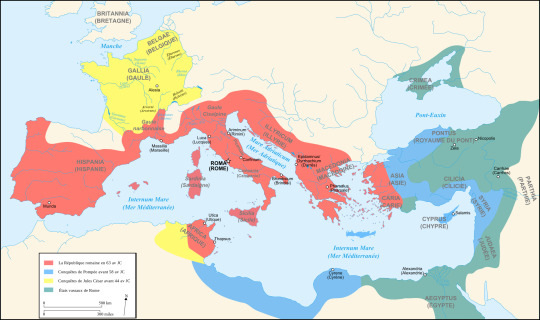
The Late Roman Empire right before Caesar’s dictatorship.
Red: The empire’s extent at 68 B.C.
Yellow: Caesar’s conquests as military commander
Blue: Pompeii’s conquests
Green: Roman client states
Afterwards, there were the Marian reforms, named after the populist Gaius Marius, which turned the Roman army into a paid professional force and then the dictatorship of his enemy Sulla. Eventually we reach the age of Julius Caesar, who established a life-long dictatorship before being murdered, his successor, Octavian (Augustus), took over and formed the Roman Empire. Caesar’s solution to the state of the average citizen was to provide them the famous “Bread and Circuses”, he created and expanded the Roman welfare state in an effort to win over the people. While this program is often disliked as a dictatorial measure to pacify the masses, I believe it is important to judge it compared to the previous state of life. Despite that, it would still be appropriate to call it a band-aid solution at best.
Throughout all of these changes, Greeks remained mostly unaffected, only being involved in the wars, civil wars and one major failed revolt, where the Greek regions were devastated for a few years. The emperor Hadrian at one point went to Greece, where he had served as Archon of Athens before the start of his rule, and tried to organize the Greek cities into an autonomous Koinon (Commonwealth/League), which was not materialized de facto in any way unfortunately.
At this point in time, Christianity appears as a faith, first mentioned around 70 A.D., it spreads to many of the Eastern Roman provinces and Greeks are some of the first ethnic groups to convert to it, creating substantial Christian communities all over the mainland, its islands, the coasts of the Levant and Asia Minor. By the 4th century, Greece is almost completely Christianized.
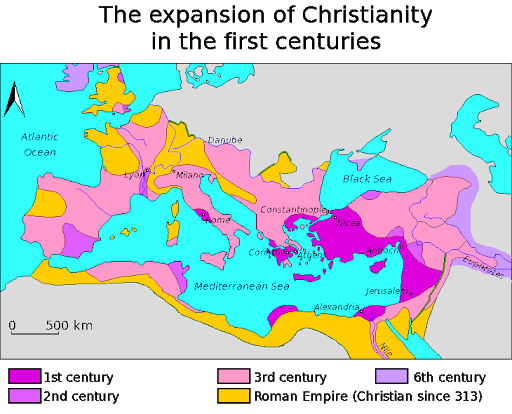
The Roman empire was eventually split into two parts by Diocletian, in order to be more efficiently governed. This cut off the more wealthy eastern provinces from the western Empire, which was in great need of funds. The Western Roman empire was barely able to last 170 years after the split, whereas the East lasted, in one form or another, until the 15th century A.D.
After the fall of the Western Roman Empire, we arrive at the Eastern Roman Empire, with its capital in Constantinople, where emperor Justinian takes the Throne in 527 A.D. He implements great legal and economic reforms, strengthens the army and sends it to many of the fallen parts of the former Western Roman empire to take them back. With his capable general Belisarius by his side, he conquers north-western Africa/former Carthage (modern-day Tunisia and north Algeria) from the Vandals, takes back Italy from the Ostrogoths and pushes the Visigoths of Spain to the interior, gaining back its south-eastern coast. These great conquests stretch the empire’s armies thin, greatly burden its economy and, combined with a devastating plague, lead to the rapid loss of all that land not even 50 years after it was attained.
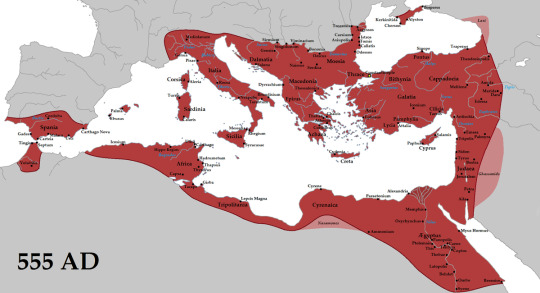
Justinian’s Empire by 555 A.D.
This is often considered the beginning of the Byzantine Empire. With the loss of these territories, the empire is once again isolated mostly to the territories of the Greek population, with the only notable exceptions, Egypt and the Levant, being lost to the emerging Arab caliphate of the Rashidun and its new faith of Islam.
The Arabs would be the main enemies of the Hellenized Eastern Roman Empire until the arrival of the Turks in the late 11th century.
The Byzantine empire is considered to have become officially Greek with the reign of Heraclius (610 - 641 A.D.), who made Greek the official language of administration in the empire, abandoning Latin.
The powerhouse of the Byzantines was Asia-Minor for the most part and it was generally concentrated in Asia-Minor and Mainland Greece, occasionally ruling over most of the Balkans and parts of Syria but rarely having the strength to venture further.
Within the Byzantine Empire we get the formation of the Christian Orthodox dogma, traditions and structure. Even before the official split with the catholic church in 1054.
The Byzantine empire was legally an elective autocracy. The Emperor was viewed as a politically-neutral defender of justice and the Christian faith, the role was likened to the referee in a sporting event, handing warnings or punishment to bad actors and prizes to fair winners. The elective element came from the legal requirement that the successor to the emperor should be chosen through a vote of the senate, something which could be (and always was) bypassed by 2 methods: The emperor had the right to appoint a co-emperor/caesar/despot (the name of the title changed over time), who functioned as a vice-president of sorts, and that individual would become the emperor after the old Emperor’s death. So emperors chose their successors by handing them the office and made elections redundant. The other route was a palace coup or open rebellion. Byzantine politics were generally very cut-throat affairs and political ministers had to always watch their backs for rivals while also avoiding the emperor’s wrath.

In 1071, Byzantine forces are defeated at Manzikert by migratory Turks, who proceed to invade Asia Minor and conquer as far as the Aegean coast, the picture above shows the areas of control around 1081.
The Byzantine emperor Alexios I seeks aid from the Pope and Western Europe in beating back the Turks and Arabs, this call for help is utilized by the pope to start the first Crusade. The first few crusades help the Byzantines reconquer much of Asia Minor again, helping the “Komnenian restoration” period of Byzantium, even if they also lead to territorial disputes with the new Crusader states of the region.
Despite that, after only a few years Byzantium keeps declining territorially and is dealt a great blow during the 4th Crusade, which gets derailed by an exiled Emperor who promises great wealth to the Crusaders if they take Constantinople for him. long story short, they take it, he cannot pay them because the treasury is empty, they loot the city and divide the empire amongst themselves.
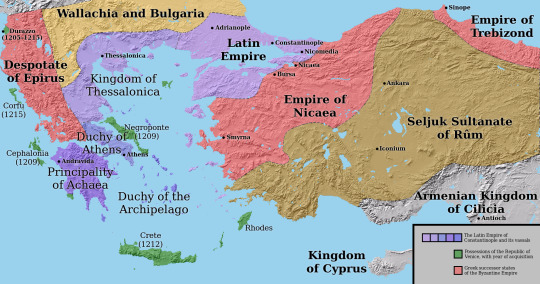
Some Greek Byzantine remnant states are created, with the most important among them being the Empire of Nicaea, the Despotate of Epirus and the Empire of Trebizond. These gradually kick the Latin states out of mainland Greece and Anatolia, until the empire is reunited by the Palaiologoi dynasty of the empire of Nicaea.
After some internal fracturing of their own, the Turks unite behind the relatively new Ottoman dynasty-state and start conquering the Greek mainland and Balkans during the 14th century, until finally taking the city of Constantinople itself in 1453. Ending Byzantium, the final remnant of the Roman empire.
7 notes
·
View notes
Text
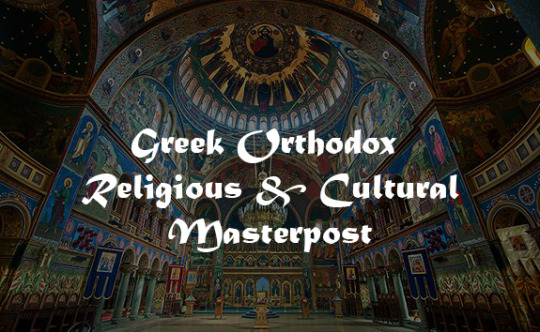
This post is based on my knowledge of traditions of the north and center mainland of Greece. However, I am pretty sure most of those things apply to Greek Orthodox people universally. Needless to say, each village and town can has its own local traditions when it comes to religious occasions.
I am a Greek Orthodox living in Greece, raised into the religion.
I will translate some phrases directly, hoping to give a more “raw” meaning.
If you are not sure you understood about certain information in the post, feel free to ask me on Tumblr!
Google Drive Link for the post in .docx format
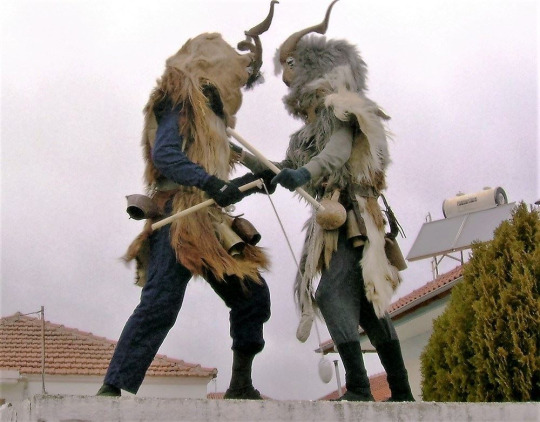
Table of Contents
Philosophy.
The Church as a building and as a center of faith.
Chapels and even smaller churches.
The Communion.
Livanisma / Thimiama – Incense burning.
Home Altars.
Clothing.
Komboskini - The prayer rope.
Tama - Votive
Crosses in high places.
Wedding
Baptism
Wedding & Baptism.
Burial customs and honoring the dead.
Agiasmos - Blessing.
Protomaya.
Martis - The protective bracelet of Spring.
Easter Traditions.
Vasilopita on Christmas
Kalanda
Mount Athos
Pilgrimage to Tinos
The Catching of the Cross
More customs
Random Information
1. Philosophy
Love and Forgiveness are the main pillars of the faith. Some people follow the Bible to the letter, others pick the parts that think reflect our age and most of people keep the general message of the teachings. The Holy Texts are interpreted differently by different people and there can be contradictions in lifestyles and believes. However, the notion that having love and forgiving is what makes you a Christian is widely believed.
Anyone who does not love does not know God, because God is love. - 1 John 4:8
Love is patient, love is kind. It does not envy, it does not boast, it is not proud. It does not dishonor others, it is not self-seeking, it is not easily angered, it keeps no record of wrongs.- 1 Corinthians 13:4-5
There is no fear in love, but perfect love casts out fear. For fear has to do with punishment, and whoever fears has not been perfected in love. - 1 John 4:18
Don’t say ‘I am hated, and that’s why I do not love‘. For this is why you out to love the most. - Ioannis Chrysostomos
“But I say to you who hear, Love your enemies, do good to those who hate you” Luke 6:27
“Do not judge, and you will not be judged. Do not condemn, and you will not be condemned. Forgive, and you will be forgiven.” - Luke 6:37
"Then Peter came to Jesus and asked, 'Lord, how many times shall I forgive my brother or sister who sins against me? Up to seven times?' Jesus answered, 'I tell you, not seven times, but seventy-seven times.' " - Matthew 18:21-22
2. The Church as a building and as a center of faith
Jesus and the Apostles gave us some directions for the worship but most of practices, as well as the architecture of worship came from the Greeks themselves. I jokingly say that Greeks are low key pagans, because religion didn't change the culture. (It did, but only a bit). Christians first worshipped inside the old temples of the Hellenic gods (the Parthenon was once the temple of Virgin Mary) and they built their first churches in that style. The architecture changed with time but it still carries the mark of ancient temples.
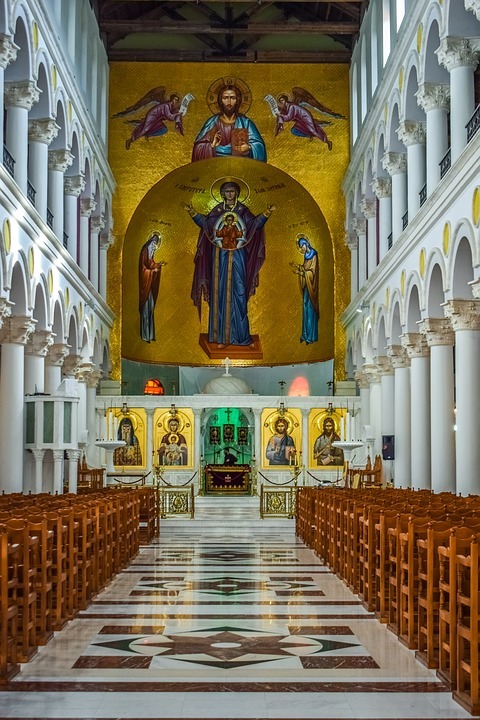
Agios Demetrios Thessalonikis
In this link you can view the different styles of architecture for Greek Orthodox Churches. (Link)
In Orthodox churches you don't have to have a feeling of the dominance of God, like in the Catholic or protestant churches, but a feeling of warmth and belonging. In the hall you can buy a candle to light on a display of candles in the hall, to get a blessing for yourself and the soul of anyone you want. Nobody supervises you there.


You can also not pay but I haven't seen anyone not giving money, so far. After that you kiss all the icons displayed in the hall and cross yourself.
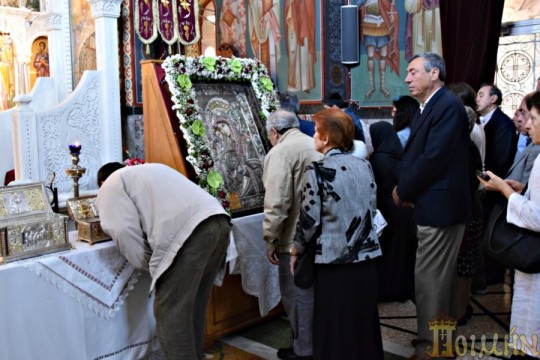
As you enter church, men on the left side, women on the right. There is also a special place for women, an interior balcony which is really cool and women go there if they want to. Nowadays man and women can go there.

3. Chapels and even smaller churches
Chapels serve the same purpose as churches but liturgies rarely happen in them. You can get married in them sometimes.
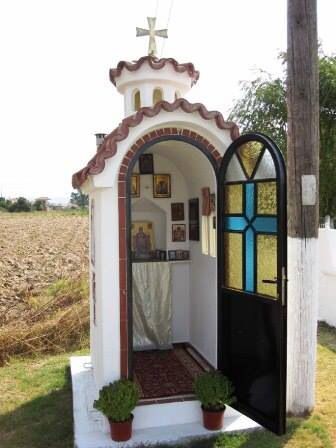
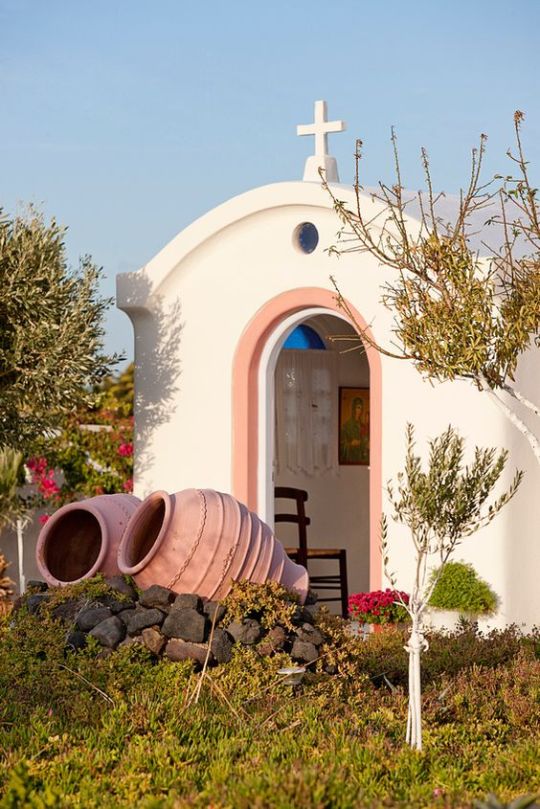
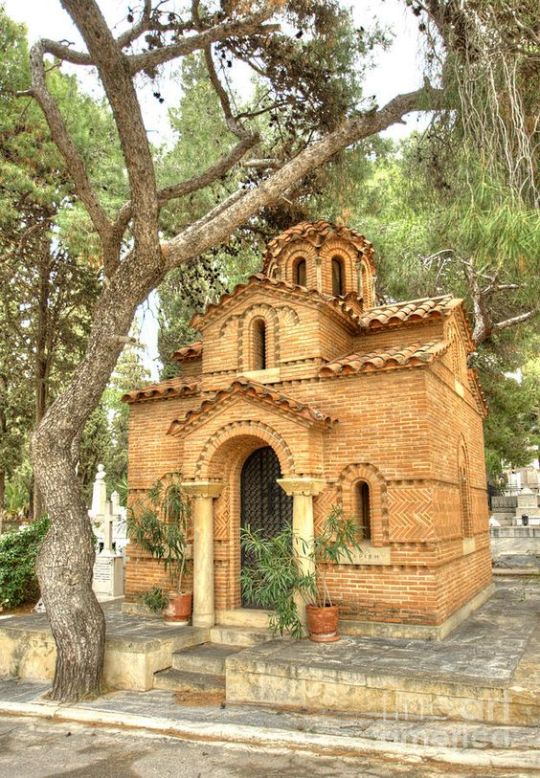
They can be carved in stone or into a cave - even in a tree or in between multiple trees.

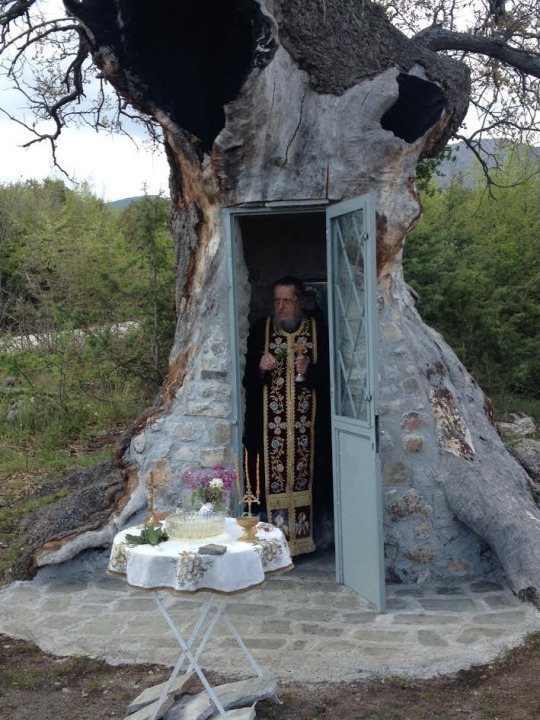

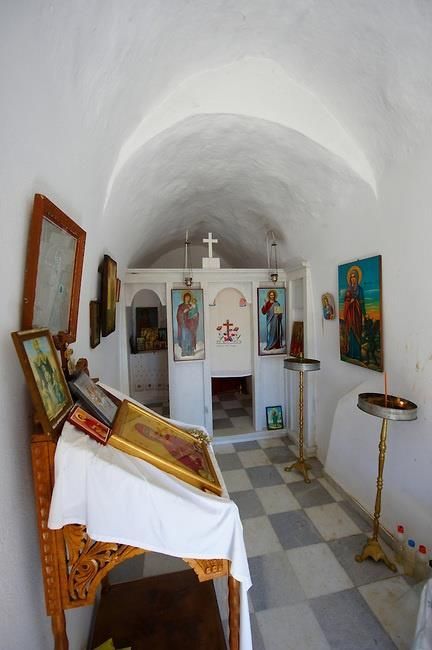
The also exist in big hospitals to bless the patients and invite people to pray for their sick.
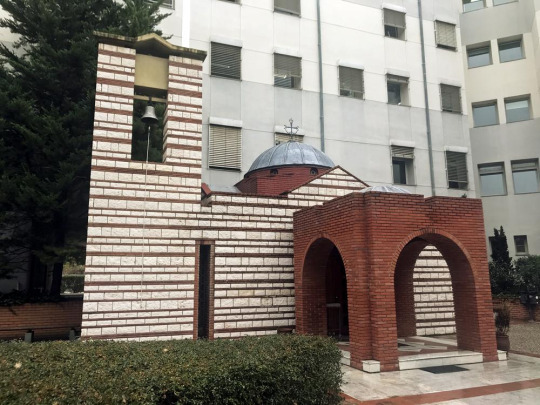

They can be seen in some big hotels, too!
But the churches can become even smaller!

Traveling the roads of Greece you will see dollhouse-sized roadside chapels. Some are elaborate little things made of terracotta or even marble, plonked in the middle of nowhere, high up in the mountains; no village or houses for miles, and yet impossibly, most of them are faithfully maintained with a candle always burning inside.
There’s a number of reasons for these heartfelt shrines, some as old as the roads themselves. Placed by the roadside, an initial assumption is that they’re built to remember a victim of a traffic accident victim, and sometimes this is exactly the case. But just as often, shrines will be built by survivors of accidents, thanking a saint at the location of their ordeal.
They can be found in home yards of people who want to come closer to God

4. The Communion
We all take part in Communion with the same spoon. The Communion has bread crumbs in. Even babies drink a tiny bit of the wine (blood of Christ). Traditionally you were "unpure" if you had your period - others believed the blood of Christ would come out of you as period blood if you drunk it, so generally getting the communion during your period is a no for many.

5. Livanisma / Thimiama – Incense burning

Today, Orthodox Christians use incense throughout the church services. The priest “censes” certain areas at certain parts of the liturgy. The incense is placed inside a device known as a “censor”, which is fairly ornate in appearance and has bells on it so that we not only smell the fragrance, but hear the jingling sound as the priest uses it. This action is meant to remind us that are prayers are rising to the heavens to be heard by God.

Typically in the Orthodox Church, dried incense cones are used. In order to provide the heat needed to allow the cones to burn, a special type of charcoal is used. You also may burn resin, such as Frankincense or Myrrh, directly in an incense burner using charcoal without taking the extra step of mixing it with a binding agent.
Churches often get their incense from special suppliers and maybe even monasteries where the monks or nuns make their own. Typical scents that are used include Frankincense, Myrrh, and Rose.
The believers can also burn incense in their homes and say prayers to ward of Evil.
6. Home Altars
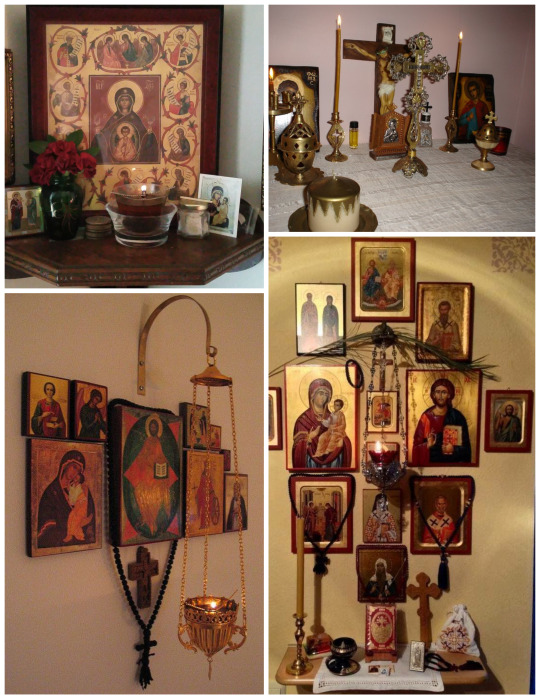
An Orthodox Christian is expected to pray (to be connected with God) constantly. According to Bishop Kallistos Ware, "In Orthodox spirituality, [there is] no separation between liturgy and private devotion." Thus the house, just like the Temple (church building), is considered to be a consecrated place, and the center of worship in the house is the icon corner.
An icon corner is normally oriented to face east. It is often located in a corner to eliminate worldly distractions and allow prayer to be more concentrated. Here is where the icons that the family owns should be located, normally including at least icons of Christ, the Virgin Mary, and the Patron Saint(s) of the family.

An oil lamp normally hangs in front of the icons. The careful trimming of the lamp to keep it burning at all times is interpreted as symbolic of the attentive daily care faithful Christians should take over their souls. Relics of saints (if the family possesses any) and a Gospel Book and a blessing cross would be kept there, as well as incense, holy water, palms and pussywillow from Palm Sunday, candles from Pascha (Easter), and other sacred items, as well as a personal Commemoration Book (containing the names of family and loved ones, both living and departed, to be remembered in prayer).
7. Clothing
People should enter the church in modest attire. No shorts and no short skirts. Women don’t need to cover their head. In fact, almost no woman under 80 covers her head in church.
With special occasions being the exception, Greek Orthodox Priests wear a black himation because of the fall of Constantinople. They wear it all the time, even to grocery shopping. They have long hair and beard. In rare cases you will see women dressed with a long black cloth - something like a burqa but the whole face is uncovered. They are nuns or devoted to Christ.
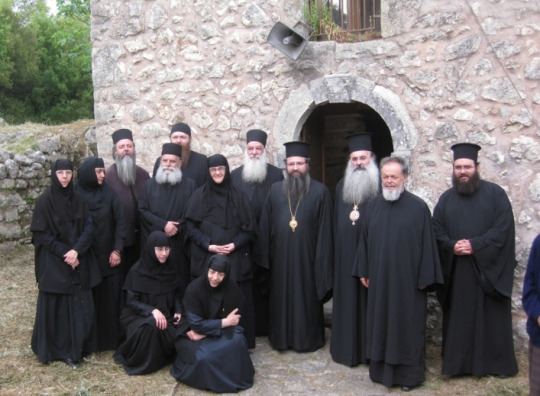
8. Komboskini - The prayer rope
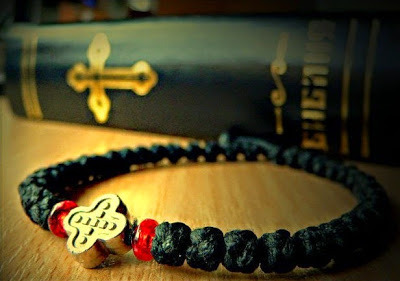
The prayer rope, known in Greek as a κομποσκίνι (komboskini), has long been a powerful weapon for the Orthodox Christian. It has a very simple design, but is filled with meaning. The rope typically comes in one of three lengths, 33 knots, 50 knots, or 100 knots, though there are some in use which are as long as 500 knots. The 33 knots of the shorter rope symbolize the 33 years Christ spent on earth.
It is used in conjunction with the Prayer of the Heart. On each knot is said, "Lord Jesus Christ, Son of God, have mercy on me, a sinner." This prayer is occasionally shortened to, "Lord Jesus Christ, have mercy on me," and other prayers are sometimes said, such as, "God be merciful to me a sinner." Prostrations can also be made with each prayer or after a certain number of prayers. By carrying a prayer rope on us discreetly, we are reminded to “pray without ceasing”.

The prayer rope is attributed to St. Pachomius (4th century). The devil would untie the simple knots he would make to count his prayers. Inspired by a vision from an angel of God, St. Pachomius was able to create a special knot composed of nine interconnected crosses (representing the nine angelic classes), that the devil was unable to untie.
9. Tama - Votive
Tama is a form of votive offering or ex-voto used in the Eastern Orthodox Churches, particularly the Greek Orthodox Church. Tamata are usually small metal plaques, which may be of base or precious metal, usually with an embossed image symbolizing the subject of prayer for which the plaque is offered.

The tradition comes from the ancient years, when Greeks offered metal or marble plaques to the gods, often for the cure of an ailment. Eyes may indicate an eye affliction, hands or legs may indicate maladies of the limbs, a pair of wedding crowns may mean a prayer for a happy marriage, etc.
Tama also means Promise. Usually the believers promise something to a saint in exchange for their help on something. My aunt made a tama to the saint Anastasia Farmakolitra ("saves through medicine") to change her name day from the day of the Resurrection to the day of Anastasia Farmakolitra's day if her daughter passed to Pharmaceutical School. Many promise to light big candles (Lambathes) as an offering to the saint or make a donation to their church. Making a lambatha in your height is a standard tama.
10. Crosses in high places
The Greeks want to feel watched over by the Divine but also leave their mark in the area they live. A way to show their devotion is to place big crosses in hills and mountains which overlook their city, town or village.
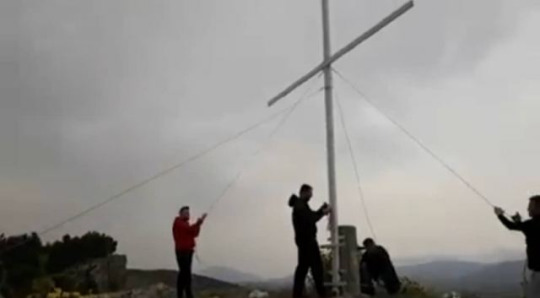
In some cases you find those crosses in high, remote places.

Some crosses light up at night!

11. Wedding
When the priest says "and the woman should fear the man" in a wedding, the bride may step on the groom's foot to show dominance.
In the bride’s shoe sole her unmarried friends write their names. The woman whose name fades first will be the first to marry
The relatives also put money into the shoe of the bride “so it can fit better“ - but really it’s just a gesture to give money to the couple
The Crowning is the highlight and focal point of the Sacrament of Holy matrimony. The priest then takes two wedding crowns (stefana), and blesses the bride and groom in the name of the Father, and the Son, and the Holy Spirit, and then places the crowns upon their heads. The Best Man or Best Woman then interchanges the crowns three times as a witness to the sealing of the union. People keep their stefana in their house and even frame them.

12. Baptism
Greeks take their names from their grandparents (since ancient years) and the name is kept a secret until the baptism.
It is a ceremonial moment because prior to the Christening, the individual is not yet part of the church family. In the church hall the priest asks the person to be christened to renounce Satan. If the individual is an infant, the godparent does it for the child. In the next major part of the ceremony, the person being baptized is immersed in the water three times, which is symbolic of Christ’s birth, death, and resurrection. The person is oiled - so they can be blessed and slip from the hands of Satan - and a tuft from their head is cut - to symbolize new beginnings, devotion to Christ and to give Satan less hair to grab them from. If baptized as an infant, after immersion the child is placed in the arms of the godparent with a white sheet, which symbolizes purity. Then, the child receives the sacrament of Chrismation.
The godparent gifts a golden cross to the baptized and, as long as the baptized is young, they buy them shoes for Christmas and an Easter Candle for Easter.

13. Wedding & Baptism
You can do a wedding-baptism to save money. First the marriage, then the baptism. If the child is about to die before a baptism gets arranged - God forbid - they get baptized in the air (and not in water) by a priest.
Koufeta (Sugar Coated Almonds) are mainly served in weddings but also when wedding and baptism happen in the same day. They are placed in little bags in odd numbers and are served on a silver tray. Odd numbers are indivisible, symbolizing how the newlyweds will share everything and remain undivided. Tradition holds that if an unmarried woman puts the almonds under her pillow, she'll dream of her future husband.
After wedding and/or baptism there is - of course - a feast with hundreds of guests.

14. Burial customs and honoring the dead
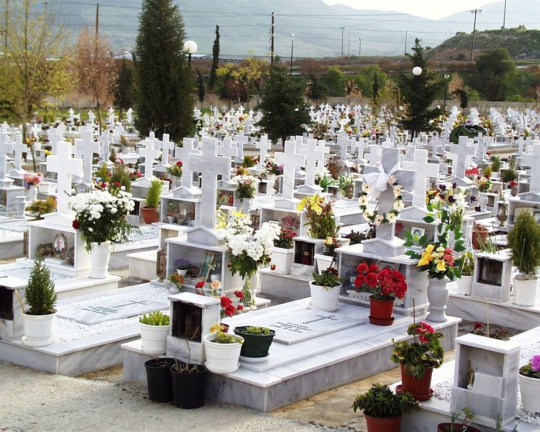
Pouring wine on the graves during the burial, as an offering or to prevent the dead from coming to life. (I am not sure but that is probably wine blessed in the church).
There is a feast after every mystery. Even funerals.There are more feasts for the dead as time passes. You have to do them in 3 days, 9 days and 40 days. You don't have to do all of them but it's showing respect to the dead and most people do them. 3 and 40 days feast are very important. For the 40 days feast - as for the funeral - there are flyers on the area, which invite people. When 1 year and 3 years pass you go to Church and the priest mentions the name of the dead in the blessings and later comes from the grave to chant.
During the Sabbath of Souls you have to bring koliva (wheat) to offer to the dead in the family. Supposedly the dead "feed" from them. So it has to be boiled!
Charon is the one who takes souls in our recent tradition.
Graves stones often have sketched pictures or photos of the deceased on them.
15. Agiasmos - Blessing
The start of the New Year in the tradition of the Orthodox Church is marked with the blessing of homes and businesses with Holy Water, or an Agiasmos (literally, to make blessed). This practice commences immediately following the Feast of the Theophany (the annual celebration and remembrance of the Baptism of Jesus Christ – January 6). This blessing is not something done for good luck or to prevent bad luck, but rather a blessing to help strengthen and protect.
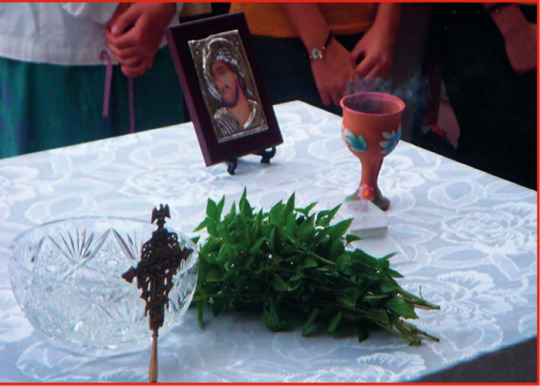
The following items are needed for the ceremony:
Small or medium size bowl, filled halfway with cold tap water
Small twig of fresh basil (floral kind)
Icon displayed behind the bowl
Hand censer, lit and burning incense during the service
The service is also provided in schools when the new school year starts. This is a particular occasion which can be annoying but also fun for the students because... water shower! Please watch this video (Link). I love it because the priest comes too close to the children - sometimes they want to bless too much - and the kids try to avoid getting wet from head to toe!
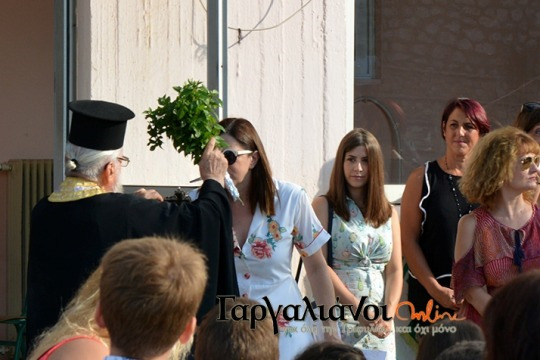
16. Protomaya
May, according to Greek folklore, has two meanings: The good and the bad, rebirth and death. The custom celebrates the final victory of the summer against winter as the victory of the life against death go back at the ancient years and accumulated at the first day of May. This day was also dedicated to the goddess of agriculture Dimitra and her daughter Persephone, who this day emerges from the under world and comes to earth. Her coming to earth from Hades marks the blooming of nature and the birth of summer.
Another ancient celebration that Protomagia has its roots is Anthestiria, a celebration in honor of Dionysos (the Greek God of theater and parties) a festival of souls, plants and flowers, celebrating the rebirth of man and nature.
The custom of May 1st is to decorate the doors of houses with flower wreaths in a way to welcome the power of nature into our home. The wreath is made from various flowers, handpicked and knitted together. In some parts of Asia Minor, people put on each wreath, except flowers, a garlic for the evil eye, a thorn to protect the house from enemies and an ear for good harvest. The wreaths adorn the doors of the houses until the day of St. John the Harvester (June 24) when all the wreaths of the neighborhood are gathered and burnt in a big fire, the fire of the saint.
See my hashtag #protomaya for more
17. Martis - The protective bracelet of Spring

It’s said it’s an ancient tradition dating back to the cults of Demeter and Persephone. Eleusis was the ancient city where the ancients performed secret rites for the cult. As a form of initiation into the cult, which was one of the Eleusinian Mysteries, the faithful wore a bracelet called a “kroki” around both their right hand and left ankle. Amazingly, the ancient tradition still lives on today in modern Greece. However, there are certain rules that one must abide by when creating and wearing the symbolic bracelet which celebrates the arrival of Spring.
Most importantly, the bracelet must be woven on the last day of February and it must be made of white and red thread. The white thread of the bracelet symbolizes purity while the red represents life and passion.
In ancient times, people believed that the bracelet helped protect the person who was wearing it from diseases, as well as the strong rays of the spring sun during the month of March. Today they say it protects from the strong rays but also the cold of March. Since it’s a transitional month you can burn from the sunrays but you also need wood for your fireplace!
Part of the ancient tradition in Greece calls for the person wearing their red and white “Martis” bracelet to take it off and tie it to the first flowering tree they see in March, in order to yield a healthy harvest and to keep the tree healthy.
Another practice with Martis bracelets occurs when the first swallow of the Spring is sighted. The first person who sees a swallow upon the bird’s return from its winter migration, ties their bracelet around the nearest rose bush to encourage the bird to make its nest there.

18. Easter Traditions
Easter is the biggest celebration of the Greek Orthodox tradition. The Holy Week, preceding Easter Sunday, is a time to ponder on Jesus’ Passion and Crucifixion. It is often regarded as an opportunity for body cleansing through fasting, visiting their town of origin and embracing local traditions.
We fast for 40 days (cutting more and more foods every week). Before the fasting we have Tsiknopempti when we eat as much meat as we want, to give our body what it needs before cutting it for 40 days. (It's sort of a celebration and people go out). University restaurants and private restaurants always have fasting options this period. The first day of the fasting is called Clean Monday and it's also like a celebration. It’s the first day we start eating “fasting” food and we also fly kites!
Kyra Sarakosti - Lady Lent

She can be made out of paper or dough. Lady Lent has seven feet. They represent the seven weeks of Lent. Each passing week, on each Saturday, children get to break off one foot. This is a great visual way to countdown the weeks until Easter.
Lady Lent has no mouth. The missing mouth symbolizes fasting. No consumption of meat, dairy products or eggs. She has no ears, this means that she refuses to listen to gossip. Her cross represents the easter religious services in the church, her hands are folded for prayer.
After the last foot is cut off, it is tradition to place this foot in a bowl with fruits and nuts and whoever finds it receives a special blessing.
You don't have to fast if you don't want to. Fasting from bad thoughts and words is equally - if not more important - than food fasting.
Epitaphios threnos (funerary lamentation) is the name of the matins of Holy Saturday, served in Good Friday evening. Within a liturgical context, this is also the name of an icon, usually made of cloth and richly embroidered, depicting the body of Christ being laid in the grave, often by the Virgin Mary and some disciples.
On Good Friday morning, the icon is placed on a platform, resembling a bier, typically topped with an elaborately carved wood canopy. In most cases, the canopy is heavily decorated with ornate flower arrangements, ribbons and sometimes candles. Young girls (the "virgins") have to adorn it with flowers.

Throughout the day, people can come into the church and venerate it. Kids have to pass under the platform in order to take a blessing.
In the evening the service begins; near the end of the ceremony, the canopied platform bearing the icon is lifted on the shoulders of priests or churchgoers (usually four to six people) and carried through the streets followed by the believers.

In towns with more than one parish, the processions starting from different churches may converge to a single spot (usually the town square), where they temporarily stop and a common hymn is sung before they resume their routes. In large towns, the chants are often performed by a marching band.
The epitaphs in the Central Square of Larissa (Short Video)
These practices have numerous variations according to regional traditions. On the island of Zakynthos in the Ionian, instead of an embroidered cloth, a lamb is used: this is a figure of the dead body of Christ, cut out from board and painted from both sides, placed vertically so that it can be seen from either side of the bier. Another famous custom, the “burning of Judas”, where an effigy of Judas is set aflame on a bonfire, is usually regarded as an Easter Sunday ritual; in some parts of Thrace and Macedonia, however, it takes place on Good Friday, after the procession. In some coastal towns, most notably on the islands of Hydra and Tinos, the men carrying the Epitaphios march right into the sea, until they are at least waist-deep in water, where they may remain for several minutes, often holding the platform high to protect it. During this time, prayers are said for the welfare and safe return of the many seafarers coming from those communities.
Watch footage from the Epitaphios procession in Kaminia, Hydra (Short Video Link)
Τhe flowers used for the adorning of the Epitaphios are considered blessed and women used to put them under their pillow for protection or to dream their future husband, or to put them in talismen for their beloved or use them as medicine, or they put them in the home altar.
On 00:01 on Easter Sunday the priests happily chant "Christ has risen from the dead!" in one of the most known and iconic chants in Greek Orthodoxy. There are fireworks and we kiss each other on the cheek having this exchange: - Christ has risen! - True! This exchange is used by many as a greeting for 40 days after the resurrection. In the Resurrection the priest offers the Holy Light and people go to get it and pass it to their own company or anyone else who asks for it. The candle is held in candles you buy yourself but for children their god parents buy them. With the smoke of this fire you make a cross above your door and you don't clean it up - never. A door can have multiple black crosses above it. With the Holy Light you light up the lamps of your home altar. Some people have breaking eggs contests right after the announcement of the Resurrection, others do them when they come home. We also eat a special soup that night called Magiritsa. It has meat so with this we cut our feast. When the morning comes we host family gatherings and eat as much meat as we want.
19. Vasilopita on Christmas
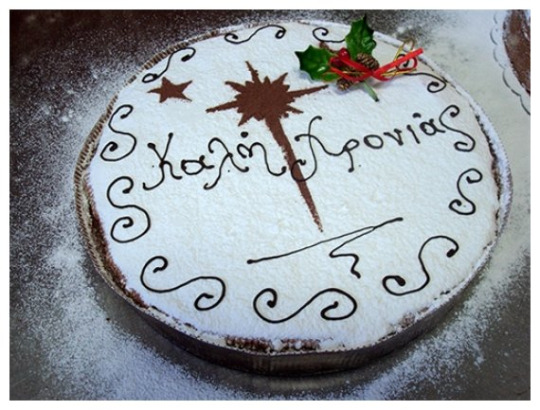
The Greek word Vasilopita is directly translated as “Sweet Bread of Basil”. When the Vasilopita is prepared, a coin is baked into the ingredients. When the observance begins, usually on New Years Day, the bread is traditionally cut by the senior member of the family, and the individual who receives the portion of the Pita which contains the coin is considered Blessed for the New Year.
Vasilopita is also cut in educational institues and the workplace. Whoever finds the coin usually receives a gift.
This age old tradition commenced in the fourth century, when Saint Basil the Great, who was a bishop, wanted to distribute money to the poor in his Diocese. He wanted to preserve their dignity, so as not to look like charity, he commissioned some women to bake sweetened bread, in which he arranged to place gold coins. Thus the families in cutting the bread to nourish themselves, were pleasantly surprised to find the coins.
20. Kalanda

Caroling (kalanda) has roots in ancient Greece. Children would carry small boats and sing songs honoring Dionysius. In Ancient Greece the children would praise the head of the household. At this time in history they would also gift the head of the household with an olive branch, which signified prosperity. Greek Christmas carols date back to the Byzantine times.
After singing for the household, the children receive money (and sometimes sweets). Before the financial crisis one could gather hundreds of euros from Kalanda.
Children say Kalanda on Christmas Eve, on New Years Eve, on Epiphany Even and Lazaros Sabbath. The songs are different for those four occasions.
21. Mount Athos
Mount Athos is a mountain and peninsula in northeastern Greece and an important centre of Eastern Orthodox monasticism. It is governed as an autonomous polity within the Hellenic Republic. Mount Athos is home to 20 monasteries. It’s commonly referred to as Agion Oros (Άγιον Όρος, 'Holy Mountain').
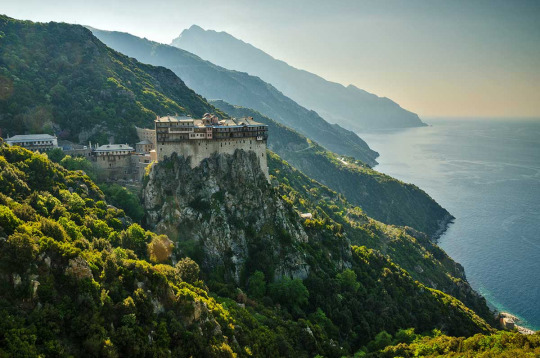
According to the Athonite tradition, the Virgin Mary was sailing accompanied by St John the Evangelist from Joppa to Cyprus to visit Lazarus. When the ship was blown off course to then-pagan Athos, it was forced to anchor near the port of Klement, close to the present monastery of Iviron. The Virgin walked ashore and, overwhelmed by the wonderful and wild natural beauty of the mountain, she blessed it and asked her Son for it to be her garden. From that moment the mountain was consecrated as the garden of the Mother of God and was out of bounds to all other women.
22. Pilgrimage to Tinos

15 August is a national holiday in Greece and sees a mass departure from the cities to the islands and holiday homes in the mainland. However one island in particular witnesses more activity than most; the island of Tinos. Across Tinos are churches and shrines, the most famous of which is Panagia Evangelistria, the most holy church in Greece which houses the ‘Miraculous Icon of Virgin Mary’. In the Greek Orthodox religion, the Icon is considered to be the protector of all of Greece.
In the Orthodox Church the 15th is ‘Virgin Mary Assumption Day’ where the Virgin is believed to have ascended to heaven. The ritual of travelling to pay homage to such a sacred Icon at this time is highly emotional for Pilgrims, with the Holy Icon in Tinos serving as a main passage between the Virgin and the believers who seek comfort and miracles on their trip.

Often pilgrims crawl to the church from the boats that they arrive on on their hands and knees to show their devotion and pray for compassion, good health and healing. The final part of the pilgrimage often happens in the blazing heat which makes the effort even more momentous.
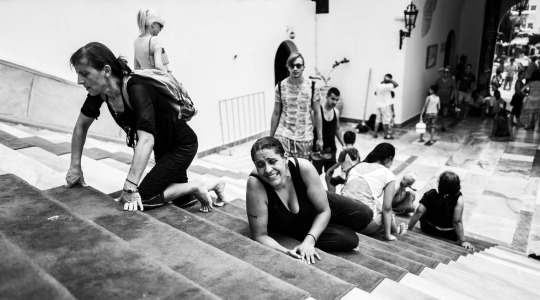
The atmosphere at and around the Church in the days proceeding the event is sincere and intense. Other pilgrims will arrive at Tinos the night before and sleep in front of the Church to ensure they have the opportunity to see and pray to the Holy Icon.
On the day itself the Holy Icon is carried through the streets of Tinos by members of the Greek army and navy, followed by the Greek Orthodox priests, political figures and the public. The procession leads down to the port when the Icon is stationed on a marble podium and speeches are made. The desire of members of the public to touch the icon often leads to a frenetic atmosphere as pilgrims try to touch the Icon itself. After the procession and speeches the Holy Icon is returned to the Church.
__________________________________________
In the same day Epitaphs of the Virgin Mary are honored and are taken to the streets so everyone can pay their respects.
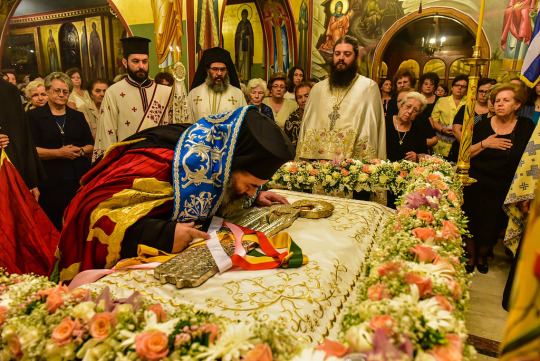
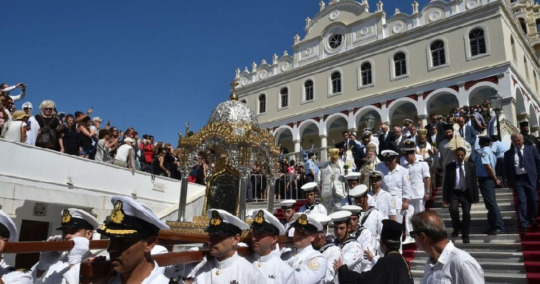
23. The Catching of the Cross
On the sixth of January, the Christmas holidays in Greece officially come to an end with the ‘festival of light’ (‘ton foton’ in Greek), also known as Epiphany.

In the Greek Orthodox Church, Epiphany is celebrated as the revelation of Christ as the messiah and second person of the trinity, at his baptism, by John the Baptist, in the River Jordan.
Another cause for celebration in the Greek Orthodox Church on this day is that Christ’s baptism was only one of two occasions when all three persons of the trinity revealed themselves, at the same time, to humanity:
God the Father, speaking from the clouds, God the Son, being baptized in the River Jordan, and God the Holy Spirit, revealed as a dove, descending from heaven.
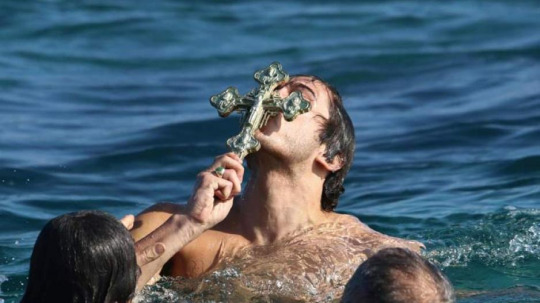
On Epiphany, the Greek Orthodox Church performs
the ‘Great Blessing of the Waters’.
This ceremony is usually performed twice, once on the eve of Epiphany which is performed in the church, and then again on the actual day outdoors with priests blessing large bodies of water, sea, rivers, lakes etc.
The tradition is that
a priest, surrounded by brave young men and boys, throws a cross into the sea, either from the harbour or from a boat at sea; the minute the cross leaves the priest’s hand, the divers jump into the freezing water to catch the cross. The lucky one who finds and returns the cross is blessed by the priest. As the cross is victoriously brought back, the priest releases a white dove, as a symbol of the holy spirit.
This tradition is carried out to commemorate the baptism of Christ and to bless the waters.
24. More customs
Each city, town and village is protected by a different saint. When the saint of the area celebrates a fair is organized. There is music, dance and stalls where the peddlers sell their merchandise.


But Greeks know that some of their customs are not approved by the church. We do it anyways and sometimes the priests join, too!
Το celebrate the Epiphany and chase away the evil spirits some residents dress up in scary attire and make a lot of noise with their voice and bells. They drink excessively, they dance and even fight with each other “to the death“ (it’s fake, don’t worry!). This custom exists in many areas of Greece, from Thrace to Cyprus. Even though the people who dress up have many names - momogeroi, babougera, ragoutsia etc - they all symbolize the carefree spirit, childish fun and trickery. Don’t get in their way because they will chase you though the village!

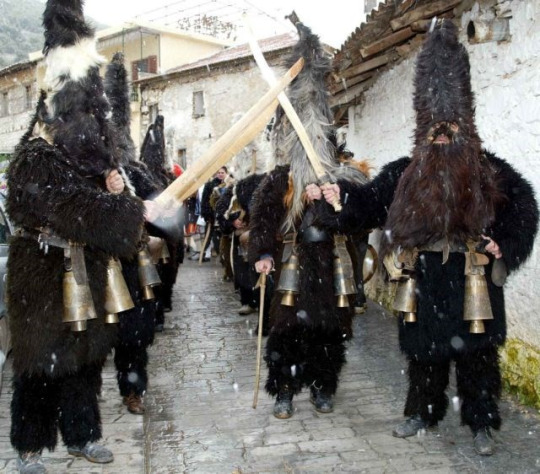
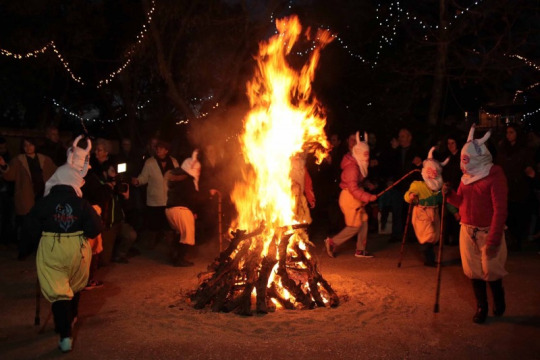
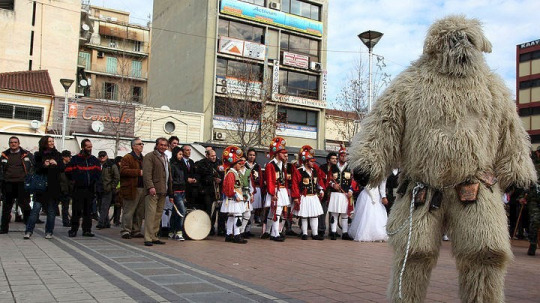
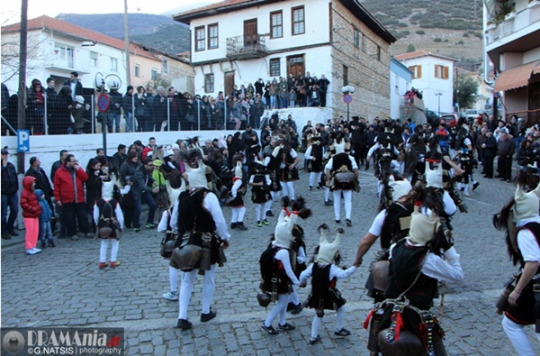

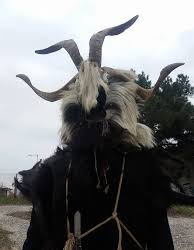
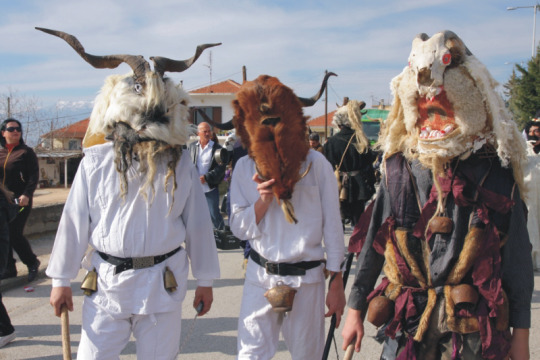

In these festivals there are different characters like the bride, the devil, the cop etc, who can symbolize fertility, the New Year, the Old Year and other concepts.
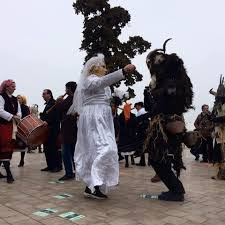

Sometimes the bride (usually played by a man) is abducted and it’s said to be a remnant of a re-enactment of the abduction of the goddess Persephone by Hades.
In other areas the Dionysiac character of the festival is eccentuated by the presence of a man who pretends ot be the god of wine, vegetation, happiness, Dionysos.


In some areas there is also dancing around a gaitanaki!

In some areas a fake camel (three people under a cloth) is presented on the streets. It probably started as a spectacle for kids but in some cases today it’s a symbol of resilience and patience. It can also remind us of the magi who rode camels to visit baby Jesus.
There is also the story where a Greek woman is abducted by a Turk and three young men pretend to be a camel to enter the Turk’s wedding with her and steal her back! (Something like the Trojan Horse!)


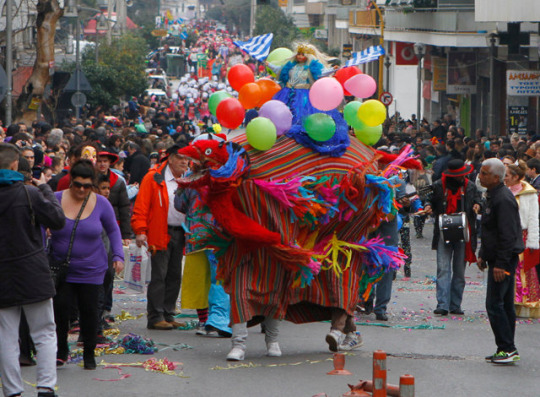
25. Random Information
Namedays are the days when the saint who has your name died. It's said that you actually take your name from them - even if it comes from your grandparents the saint is the reason you have it. In that day you bring treats to your school or work, or you treat your friends to drinks or coffee. People give you wishes ("enjoy your name" is the most common) and they call you on the phone to wish if they are away. The most common name in Greece is Maria and in Maria’s nameday everybody has to call half of their relatives and friends to wish. It’s a bit offensive if someone doesn’t remember your nameday or if they don’t call.
We bring food to the workplace in happy events - like when your child was accepted into a university.
Lots of people cross themselves when they pass outside a church. They could be passing on foot, on the bus, or even when they drive a motorcycle.
You also cross yourself when you call god for protection or when you hear something strange (accompanied with "come Christ and Virgin Mary!")
Making embroidery with the face of Jesus and/or Virgin Mary is a thing.
40 days after the pregnancy women and their newborns can woman can go out of the house but they have to go to Church to be blessed by a priest first.
We say "Christ!" when a person is chocked and "Small healths!" when someone is sneezing. When a baby is yawning bad spirits could come in so we cross their mouth. We also give them eye bendants so the Evil Eye won't get to them. People spit (just saying "ftou ftou ftou") the child after saying good words for them so they can protect them from others who will flatter them with malice. The Evil Eye is recognised by the Church. See more in my #mati tag.
Bell ringing every day before the morning and evening liturgy. It also chimes every hour. On Good Friday it rings solemnly all day.
Priests are considered spiritual leaders by many in the sense they can listen to you and guide you like a psychologist. "My spiritual" people call them.
You don't have to have your mind unguarded, that's why Greek orthodoxy is against yoga which teaches the emptying of mind
Mondays and Wednesdays of all year are for fasting - just meaning you don't eat meat. Some people also fast sexually on those days.
Hatzis- (from middle eastern "hajj") is for people visiting the holy land (Israel) on pilgrimage.
The icons of saints you buy have to be blessed by the Church before you hang them, so they can offer you a connection to the divine.
Every day at school children gather in the yard and one child says the Lord’s Prayer
We don't know the hymns by heart. They are too many and long. But there are books you can read and older people (usually women) usually study them.
All the saints in hagiographies look kinda malnourished because they are supposed to avoid the earthly pleasures.
We give epithets to the saints according to their characteristics - like we did with our ancient gods.
Lots of saints probably “covered” the dominions of older deities because Greeks were used to having smaller powerful entities for different stuff (there is even a saint who helps you find stuff if you dedicate a pie to the church)
We have a set of explanations for dreams (Ονειροκρίτης). For example, if you see something very good in your sleep about a person, misfortune will find them. If you see them dying, they will live for many years.
We read the future in the bottom of the cup of Greek coffee.
From the Byzantine era and today people buy holy wood - from the cross of Christ they say - and bones of saints. In the old time those were also used for witchcraft.If you are born on a Saturday you don't see creatures or ghosts. Also people born on Saturday are lucky and whatever they wish comes true.
Dick festivals are a thing in some areas and they mostly happen on Greek Carnival. Traditional sex songs with dances are also a thing.
Virgin Mary is the mother of Greece, and you see her as a mermaid even. We are pretty chill with our divine figures - we use them in swearing a lot, too.
Many people cross themselves before and after eating.
We take oil blessed from the Church and we put it in the lamps of our home altars. We also anoint people who want to keep safe with it. (My grandma made a cross in my forehead, for example). Many take it home the myrrh produced by the bodies of saints.
We place a bone of a saint on the ground where a church is going to be built.
Sometimes we call a priest to bless our new vehicle!
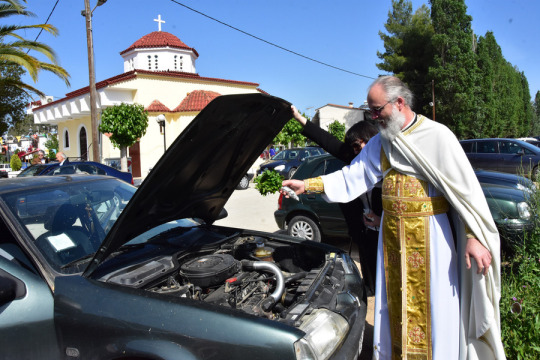

Also, it’s not a very safe practice but a lot of people hand crosses and icons from their front mirror.
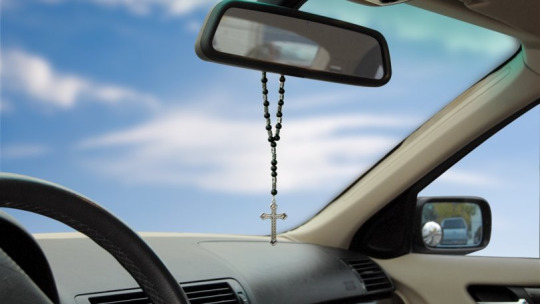
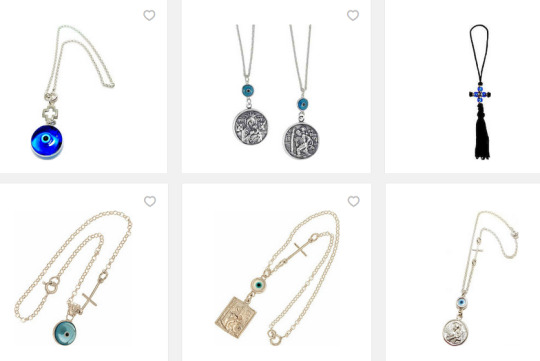
Notice that the #mati is also there!
36 notes
·
View notes
Text
Divination, magic and religious tattoos in Bosnia
Translated by Jessica Heaton from the original text in French by Jean-Claude Montbarrey
The most detailed Bosnian tattoos are drawn on the forearm, the wrist and the back of the hand. On the chest, only fairly simple crosses, in the center of a circle are drawn. *Notice here the 'hooks' which surround these circles and how they create the symbol of a rotating solar-disk.
The most detailed Bosnian tattoos are drawn on the forearm, the wrist and the back of the hand. On the chest, only fairly simple crosses, in the center of a circle are drawn.
*Notice here the ‘hooks’ which surround these circles and how they create the symbol of a rotating solar-disk.
The province of Bihac and the Una valley are among some of the most picturesque places to be found in Bosnia, they are also rich in traditional Bosnian customs. Bosnia itself is one of the most interesting regions of Yugoslavia. Bihac is a small town of between 8000 and 9000 inhabitants in the Vrbas Banovina, close to Croatia. The Una is one of the major tributaries to the Sava river, which runs pretty much from South to North and has been of strategic importance to Bosnia.
The Hungarian king Béla established a fortress here in the 13th century. In the 16th and 17th centuries, the town was invaded by the Turkish – battles ensued up until the 18th century.
A striking thing when walking in the streets of Bihac, is that many women have their wrists and forearms tattooed in prussian-blue ink. In this region’s villages, like elsewhere practically all over Bosnia and Herzegovina, the proportion of these tattoos is even more considerable. All women over a certain age – and a large quantity of young woman, are adorned with these permanent, impalpable pretty jewels.
Sometimes the whole hand is decorated with a shining circle and cross in the center, other times, the lady in question would have to lift up one of her sleeves to reveal a succession of sober, refined and harmonious geometric figures. These designs are simple by their conception of composition, minute in their details. Sometimes, the tattoos on the wrist are superposed with wide bracelets of multi-colored beads – equally geometric in their patterns. But these are far less precise and remind one of the beaded jewellery one might find in northern Africa.
despite the years, despite the wrinkles, the tattoo persists. (Bihac region, Bosnia)
despite the years, despite the wrinkles, the tattoo persists. (Bihac region, Bosnia)
The photographs shown here give an idea of Bosnian women’s tattoos. The fundamental figures which constitute these designs are the crosses, they are generally drawn on the insides of circles, the circle is practically always shining – like a solar disk and the little hooks seem to indicate its rotation. On each of its branches, the cross is barred, arrowed or branched out further.
If you add to these elements, palmettes dots, and ogives you have, by their juxtaposition and imbrication, a whole range of decorative possibilities…The chest is also tattooed: simple, forked crosses, sometimes aureoled are drawn on the breastplate, and, on very rare occasions on the forehead too. The most detailed though, are always on the right or left forearm.
These tattoos are especially worn by Catholic women, rarely on those of Orthodox faith, never on those of Muslim faith.
Bosnia, is a veritable melting-pot of religions. The west regions of the kingdom of Yugoslavia: Slovenia, Croatia, and Dalmatia were under the control of the Habsburgs until 1913. Their neighbouring countries, Austria and Italy are of Catholic faith. The eastern regions: Old Serbia and Montenegro – who little by little took back their independence from the Turks, are Orthodox. The central regions: Bosnia and Herzegovina, were passed from the Turks to the Habsburgs; their populations are a mixture of Orthodox, Catholic and Muslim, Sarajevo counts no less than 90 Minarets. There are also important communities of Sephardic Jews who came from Spain in the 16th century.
Bosnia was truly the frontier between the empires of the east and west: Byzantium and Rome. After the fall of these empires, the east and the west continued to fight, alternating between advance and retreat. In the first half of the middle ages, the region was mostly Catholic. In the 11th century the heresy of Bogomils ( a sort of Manichaeism – similar to that of the Albigensian Crusade in the Midi region of France) marked an offensive return of The Orient. The Bogomils were favored by local authority figures, who saw in them an element of independence in regard to Hungary. Following this, Rome sent Franciscan missionaries to reconquer the country with the Catholic faith. This continued for a long time. The Bosnian clergy, then the Turkish arrived in the 15th century and showed themselves very tolerant – at least while they stayed powerful (not yet under the threat of Vienna.) The Bogomils – and part of the population converted to Islam. Of all the muslims in the Ottoman empire, it was the Bosnians who remained the most traditional: they revolted against the reforms of Sultan Mahmoud – jealously holding onto their fez and turban, as well as the women’s veils which have only just ceased to be worn in Albania. All these different confessions generally get along very well together.
On the occasion of Slavas, the most important celebration on the Serbian calendar; the traditional banquet is preceded by a religious ceremony. At the head of the parade: a pope, a priest, mufti or a rabbi advances for their mixed followers, two christians in front of a portable alter, the muslim on his prayer blanket, the rabbi standing tall.
This brief portrait of Bosnia’s religious history has not, as we might believe, distanced us from the tattoos. Ethnographers have discussed and written at length concerning this subject. What we do know, is that this tradition is very old, prehistoric even and quasi-universal.
Tattoos have regressed among many civilised peoples, we find them only in certain classes and certain professions; criminals and non-conformists have a particular predilection for lettered, schematized, or symbolic inscriptions by which they express what they think of society.
All the same, when snobbishness mixed with this, tattoos became fashionable for a while within the English aristocracy at the end of the last century. Apparently, even the future Prince of Wales, Edward VII was tattooed with the symbols of his armories – in seven different colors.
As for the Tzar Feru de Cabale, he apparently had a magical japanese tattoo – which didn’t exactly bring him good luck…
It’s a different story for the primitives and ancients; where one makes the observation that a tattoo is a response to a psychological human need: it serves, depending on each case and evolutionary stage, as a mark of recognition, of religion, of infamy, of preeminence, of affiliation, as a protective amulet, prophylactic, curative, or as an ornament. Such is the word of Theophile Gautier: “The most brutal man, feels, in an instinctive way that the decoration traces a line of impassable demarcation between himself and the animal. And when he can’t put the emblem on his clothes- he will embroider his own skin.” However, the most profound and frequent arguments for tattoos are of religious or magic significance.
The savage would engrave in his own flesh, an image of his totem. The devout would write on his forehead, in indelible ink the sign of his god. The Maenads tattooed themselves like we see on their 5th century vases: a goat on the thigh, and the Baccantes, an ivy leaf on the forehead.
The people of Athens imposed on the foreheads of their prisoners an image of the owl of Pallas; the first Christians sometimes wore Christ’s monogram; Pilgrims from Jerusalem in the 17th century tattooed themselves – so informs us The Doctor Goarant de Tromelin,- with a mixture of ink and ox fat. Caterina Pigorini Beri studied the religious tattoos of Notre Dame de Lorette’s pilgrims, these were then outlawed in the 19th century. In the Muslim Orient, the Catholic syrians and Copts often wore distinctive tattoos on their wrists. In Northern Africa, each tribe has its own distinct tattoo.
Divination with beans in Bosnia, Bihac region.
Divination with beans in Bosnia, Bihac region.
So, to which category do the Bosnian tattoos belong? Most probably, that of religion and adherence to a group but with the predominance of a religious motive. It’s not surprising that the Catholics of this country, after having found themselves in confrontation with the Bogomils, then repressed under the domination of Turkish-Muslims, decided to show their faith by discreet but indelible marks. In popular culture, one can find that these sub-cutaneous drawings were seen to inject faith – preserving their wearer from maleficent influences and as a sign of recognition in the two worlds.
This silent and decorative expression of faith is different from other tattoos that one might see in Bosnia: a name, initials, a heart pierced with an arrow, a sword, an eagle etc… that one might observe on the solid biceps of the chest of a butcher or a sailor.
The operation is done by a woman, often on sundays after the service. A doughy paste of resin is kneaded with soot, explains G. Capus, who observed these tattoos all over Bosnia 50 years ago. This mixture is applied to the skin with a stick which traces the drawing. Once this is done, multiple needle pricks are applied with a needle wrapped up in string – almost to it’s point; this pushes the colored material under the epidermis which, after applying a bandage for four days leaves a permanent tattoo.
These days, this tattoo has lost it’s meaning, its primitive signification has faded but its use and practice persists. The women with the most beautiful drawings were proud to show us their tattoos.
It is probable that the use of tattoos and their function is ancient in the Balkans and goes further back than Christianity – although historical evidence in Bosnia only goes as far back as the 12th century. Herodotus taught us that Thracians judged tattoos as inelegant and badly brought up – to the point where no-one tattooed themselves. Plutarch makes the precision however that Thrace’s women were tattooed by their husbands (with scythes according to Athena) to punish them for having massacred Orpheus, and that, turning these to their advantage the multiple ‘stigmata’ of these ladies which drowned them in a profusion of drawings, eventually became interpreted as marks of honor.
In certain cases, a tattoo can be considered as a permanent amulet inscribed on the skin; the effect is obviously long-lasting but the remedy is less susceptible to adapt to the circumstances other than the exclusive use as an amulet-tattoo. This seriously diminished the revenues of charm merchants. The tattoo has not replaced the magic formula, it is seen rather as a compliment to it. Let us not mock the amulets, they have doubtlessly fallen into the use of charlatans and superstition.
They are the origins of the ideograms which have a real esthetic and symbolic purpose – which in turn, gave birth to writing and art. In other words: civilisation.
Amulets are frequently used in Bosnia and we have been persuaded that they are just as much used by Christians as by Muslims. But the specialists of ‘formulas’ are certainly the islamic ‘Hodjas‘ The word Khodja, Hodja or Hodza (which is the name of the actual head of Czechoslovakian government) signifies; well-read, scribe, student of theology. Arab characters, like Hebrew characters with their cabalistic and traditional numeric value, lend themselves far better to the making of talismans; inserted into geometric, symbolic drawings one obtains, if not just from an artistic point of view – remarkable results. Naturally, the Hodja use sacred names and Koranic verses but fill them with cabalistic formulas, unintelligible by non-believers:
A piece of paper, folded into a triangle is wrapped in a piece of fabric, smothered with clean wax or placed in a leather purse. This is then suspended by a red or yellow thread and worn on the chest to bring general good luck – or, on a sick part of the body, where this formula is used as a remedy, one as good as any other, and is sometimes efficient, be it just by suggestion.
This is what in Bosnia is called Zapis. Depending on the importance of a case, and the generosity of the consultant. A calligram is decorated with drawings more or less complicated, with a few or more colours, gold even, something which clearly can but re-enforce the virtue. But one can proceed more economically. A simple, little piece of dirty paper can, for a small price heal a headache.
The Bosnian Hodja, gives his client a prescription -its precise, meticulous execution will favor the action of the Zapis. For example; the sick person must breathe incense, wash with the water from a specific spring while making a prayer etc…
*
A large number of incantations and rituals exist for making spells that incarnate one’s desires based on the two main principals of magic: contact and analogy. For example, a young girl who wants to marry a young man could make him drink some coffee in which she would put some pomade previously worn by herself; or, she looks at him through a padlock, closes this padlock and throws it in the river. In the first case, the fluid of desire and kindness is supposed to pass from one being to the other, in the second, the closing of the padlock on the perceived image is a parallel of taking possession. To get a woman’s hand in marriage, there exists a more complicated recipe that requires a certain amount of patience: decapitate a snake, place a grain in its mouth and bury it’s head. If the grain sprouts – and an ear of corn grows forth: take one of it’s grains and touch the woman with it…
The Sunday clothes of Catholic country folk in the region of Kotor-Varoch
The Sunday clothes of Catholic country folk in the region of Kotor-Varoch
One of our fellow countrymen who has lived in Sarajevo, Mr Pelletier, wrote down regarding amulets, this tragic story at the beginning of the Austro-Hungarian occupation: one day, a young Catholic girl was seen leaving the house of a Muslim hodja with her throat slit, falling down in the street to die. The Hodja declared that she had come to ask for a spell to help her obtain the marriage she desired. He apparently refused and in her despair, she killed herself. Even dead, the judges condemned her but the Muslims believed in her innocence and considered her a martyr.
A lugubrious chant is still used today to lament the torture of someone who is to be executed. Before his hanging, the convict advises his brother; in anticipation of the witness congregation: “when you make the ceremonial clothes for your children, do the same for mine; light colours for your children, dark ones for mine, so that people will know they are orphans.”
Man desires, not only to force the spell; he also wants, unwise as it may be, to know the future. And there has existed, and exists, an extraordinary number of divination methods. The most common of these, in our part of the world are card-reading and astrology, which often compliment each other – if one might judge by the newspaper ads. But there are methods far stranger…One of these is reading through a crystal ball or a glass of water, or a basin with a shiny surface. The ancients trusted in auspicious bird-flight and bird calls; the way sacred chickens would eat – or refuse to… They were considered as sensitive detectors for invisible waves. An unsavory inspection of the intestines of victims also served to this purpose. The Geomancy; fashionable in arab countries and in Sudan was favoured in europe up to the 16th century. It consisted of interpreting figures traced in the sand, or with pebbles. These days, to simplify, the consultant draws lines from points chosen randomly; depending on if the numbers are odd or even; one obtains, four fundamental drawings which lead to others, these are then divided into 16 cases and then interpreted; depending on their positions, in accordance with the very complicated and ingenious laws of symbolism.
Another type of divination is called Belomancy which uses arrows; this method has been re-approved by the Koran. The Capnomancy; interprets smoke, Arithmancy interprets numbers which are pronounced by the consultant. This is similar to how psychoanalysis interprets associations of immediate ideas. Pisomancy is divination using peas, which are rolled on the ground. Pessomancy is when one buries pebbles and when they are lifted out of the sand the marks which are left behind are interpreted. Ptarmoscopy; interprets sneezing. To exerce Spodomancy one writes a question in the ashes – the next day one interprets what is left. Sycomancy uses fig leaves, Tiromancy uses cheese, Oneiromancy interprets dreams, Teratoscopy is when omens are deducted from spectres. of monsters, blood rains and other extraordinary phenomena . Xylomancy; uses pieces of wood found along paths and roads, Rhapsodomancy chooses, randomly, verses from Homer or Virgile, just like Bibliomancy takes a verse from the bible.
To perform Alectromancy; one places a chicken in the centre of a cardboard box where grains of wheat are placed on the letters of the alphabet, one writes down the letters which correspond to the squares where the bird pecks at the grains. Alomancy interprets the crackling and the glow emitted by burning salt crystals. Pegomancy; interprets the gurgles and air bubbles of a piece of pottery which has been plunged into a fresh water spring, Peratoscopy is similar to meteorology in that it studies the shape and direction of clouds. Divination can also be done with dice, cubes ossicles, beans, pebbles…I could go on – not to mention the reprobate Necromancy- which questions the dead, brought bad luck to Saül and resuscitated spiritualism.
There exists, in Bosnia, many forms of divination, some of them which reproduce almost exactly those of the Greeks and the Romans, while others use methods that appear to be rather of Arab or Turkish origin.
For example, to find a thief, a Bosnian will listen to his/her dream that he will have had after consulting a friend’s tomb or, an old lady will take a sieve, by a nail, invoking it to turn when the name of the thief is pronounced (this is classic Cosquinomancy) where the nail is simply replaced by pliers. One can also read the future in pigs’ guts and especially in the shoulder of a sheep (classic Armomancy)
firman
A Turkish Firman
Imagine yourself magically transported to the fireside of a family of Bosnian peasants on christmas day: The mutton is roasting on five logs, after being brought solemnly from the forest. When the beast is cooked through and through – a shot gun fire will announce that it is to be taken off the fire. Then The visitor arrives: usually a friend or neighbour. He enters, greets everybody and the mistress of the house responds to his greetings by throwing a fistful of flour at him; he will do the same, dusting her with flour and good wishes for her happiness. He will then approach the hearth – the sacred space of every bosnian house; take 2 half-burnt logs and tap them against each other; sending sparks in all directions. “As many sparks, he announces, as many little goats will give the goat, as many calfs will give the cow and young cows. Ako bog da” – (If it’s God’s will) And all reply “Amen”
The visitor then detaches the left shoulder of the roast mutton- while taking care not to damage the bone with his knife. From the configuration of the bone, the aspect of the joints etc, he deducts a series of valuable prognostics for the coming year concerning the family, the herds, harvest, wars etc. The “house” is full; he pompously predicts: Your home will be full, and the year, fruitful – but this irregular cartilage in the joint signifies a journey, and this one the arrival of a stranger. Madam Stefanik, maybe this is the year that you will marry Paul and that you will have another child – I can see a cradle from the back – it will be a boy.”
If he sees a hole in the joint then this signifies a tomb, normally, he will have the discretion to bypass this and will move on the examine the ‘cross’ of the bone which stems from the joint: A bump at its extremity signifies a debt: further up, a windfall or increased income; tiny holes indicate ruin – if one notices these it’s best to pass them by…
Under the cross is the ‘Ewe’s pen‘: if the bone is polished and lightly colored, it’s a good sign. At the base of the shoulder, each hole indicates a horned beast, if the base is wide, then this will be a good year for the oxen.; if it is split, then one will implore deaths among the cattle. Near the “cross” and to the side of the base, the holes correspond to the bee hives. The space between the jugular and the joint from the extremity of the cross to the marrow represents the fields – one can conclude from this area prognostics concerning war and peace. The cross shows the country, the marrow, the enemy; if there’s a cloud towards the extremity, then the enemy will be defeated. If the limits of the clouds are sharp, then one can hope for a peace treaty.
As this is quite a lengthly examination lots of ‘rakia’-(a fruit brandy- widely considered to be the national drink in the Balkans) is consumed before heading over to the dinner table and eating the mutton and christmas cake. After the meal, everyone lights a candle and observes on which side the flame blows. If it stretches upwards, the mountain will be fertile; if the flames incline to one side then the plain will be fertile. The father of the household then throws grains of wheat three times in the indicated direction while saying “That the wheat will grow when summer is born” And all reply: “Amen”.
During Christmas Eve, the girls like to go and listen at the neighbour’s windows and interpret the first words that they hear. The one who hears something like “sit down, stay here” will not marry this year. If however, she hears something that evokes a departure, her heart trembles.
Saint George, who is celebrated by both christians and muslims, is also suitable for consultations. A girl can dig three holes in the ground; if an insect or small animal falls ,during the night into one of them – its number indicates the year of marriage. She can also hold the door knob until she hears a passer-by pronouncing a first name – which will naturally be that of her future spouse. But this technique demands a lot of patience. The night of Saint Guy, she could place under her pillow two pieces of bread and some salt – her future will then appear in a dream. Or, in a more tragic way, at midnight alone, at the bottom of a deserted cul-de-sac she will light two candles next to two mirrors where she will see the image of the person she awaits (to marry).
Other “mancys” or methods of divination seem to be of a more ‘oriental’ origin -if we are able to assign origins to quasi- universal practices. The knowledgable Hodjas have knowledge of astrology and of the numeric and cabalistic value of letters. They know which zodiac sign presides each day of the month, which planet each day of the week and what one should do (and avoid doing) that day (just like the astrologers in some newspapers.) But a more common technique of divination is one which uses beans. It is linked to geomancy and arithmancy.
We weren’t able to photograph the “visitor” while reading the mutton -shoulder but we did manage to capture in our objective a fortune-teller near Bihac who was doing a ‘FAL‘ reading using beans.
This old country woman exercised her art with impressive conviction; the person who had come for a reading was hesitating over a decision he had to make and had come to consult her about this.
She started with some preparatory meditation – as the operation is not only a mechanical one, as well as having the ingenuity to interpret the signs, one must have intuition and a lucid spirit.
Certain metaphysicians think that cards, dice, bones, coffee, etc are just visual supports used when practicing clairvoyance or intuition…
Arab script allows the most varied,decorative combinations. Here, the characters of the prayer should be read clockwise.
Arab script allows the most varied, decorative combinations. Here, the characters of the prayer should be read clockwise.
The client was asked to concentrate on his question while posing the hand (the left hand of course) on a pile of 41 little beans; then to divide this pile into four little piles representing, from right to left the husband, the house and the wife.
The first general indication is given by the figure that is left over from dividing each group into four. Each pile is then divided into three others and then into three more, this then leaves nine piles of each group or 27 little piles of beans varying from 1 to 4 in each pile. Each pile has its own special significance and its position in comparison to the others – this leaves room for a large variety of interpretations. The closer the figure is to four (is this a distant souvenir of a hebrew tetragram?) the more likely the augur is favorable. A perfect result is ‘The hand of Hazrat Fatimah‘ the name of the Mohammed’s daughter who is equally the godmother of the populous and of Fatma. This is a well known lucky charm and is symbolised by the sign of the number five.
coloured beaded bracelets and tattoos from the region of Bihac. The crosses are generally situated in the center of the circle and most often finish with forks, tridents or even hearts.
coloured beaded bracelets and tattoos from the region of Bihac.
The crosses are generally situated in the center of the circle and most often finish with forks, tridents or even hearts.
The Bosnians also have a curious form of divination which can be found throughout the Balkans. This method is also used in the Bourgogne region of France – but also far out into the Sahara desert. One throws a spoon of melted lead in a basin of cold water; this results in a large variety of surprising forms which are interpreted, according to science or fantasy. The predominance of smooth and shiny surfaces is a good sign. If the object has more or less the form of a ship, this would signify a voyage, a cradle a birth… The Bosnians, Christians, Muslims or Jews use this process as a creative tool to heal fear and mental troubles linked to anxiety. An old woman comes to throw the molten lead three times a day during three days, each time she then administers the water to the sick person, rubs their stomach, the right hand and the left foot. The forms in the lead indicate the causes of the fear.
There is also a gracious and poetic divination method of turkish origin. This is especially practiced on Saint Georges day – whom the Muslims call Khidr or Khadir. Imagine a group of joyful young girls united around a vase full of water. Each one throws in a ring, a brooch, or other object which belongs to her. They cover the vase with a veil and one of the young girls will then pull out one of the jewels while the others sing a four lined stanza. The words of this poem can be applied to the owner of the object which was pulled out by chance – haven’t poets always been considered as inspired visionaries?
*POST SCRIPT COMMENTARY*
Like my previous post, I was unable to find any additional information about Jean-Claude Montbarrey apart from other articles which he had written for the review Sciences et Voyages.
Again, I have attempted to remain as true to the original text as possible : the term « civilisation » in this article has a certain precarity about it, the word « savages » to describe tribal people is wholly inaccurate and innapropriate. However my aim is to translate these articles in a way that they remain as close to the original versions as possible and that means to me not glossing over such elements…
5 notes
·
View notes
Text
A little Presbyterian causing trouble
So I don’t think I’ve posted on here about my exploits in ministering to the cults. Recently I’ve been witnessing to the Jehovah’s Witnesses on my way home from the gym. They just stand near the military recruitment center with their “tracts” and prey upon those who don’t know scripture. Recently The Jehovah’s Witnesses have posted “watch dogs” with their Witnesses. The watch dogs are Witnesses that I’ve evangelized to and prevent me from witnessing to the other Jehovah’s Witnesses with them. I’m honored that they think I’m dangerous enough to tell their people to not listen to what I have to say, but I’m also sad, since it prevents me from sharing the Gospel with them.
So, I’ll give you the tools to witness to JW’s. First and formost, know scripture, especially scripture that specificity talks about the deity of Christ, which is something they deny. Do not use biblical Greek, unless you actually know it or are taking classes in Biblical Greek. You’ll look like a fool if you don’t actually know any biblical Greek and some JW’s will push you on that. Secondly be upfront about your confrontation but be gentle. What exactly does this mean? I’ll give you an example: when I Witness to JW’s I ask, “why don’t you believe Jesus is God/Jehovah?” This is something that normally does catch them off guard, since they don’t have a ready made answer. Basically ask questions, you’re not on the defensive, you’re on the offensive since Christianity is true, and be gentle since they don’t know the truth. Thirdly bring up Christ’s preeminence. This is something that JW’s are not prepared to handle at all. To do this I used the Old Testament and how David is called The First born of Jesse, when he was the youngest son. This same preeminence is with Christ, with the phrase, “first born of all creation.” As orthodox Christians we believe that Christ wasn’t made, but that he eternally existed with the Father, as the Westminster confession says, “is co-equal in power and glory.”
Finally don’t get lead down rabbit holes. JW’s like to deflect questions by bringing up useless and trivial things that can be easily dismissed. Their favorite rabbit holes are, “well Jesus wasn’t crucified, he was killed on a stake,” and “why would God allow all this evil in the world? Why would Christians kill Christians,” and the last one, “there are so many churches, and they all believe different things.” All of these rabbit holes are easily dismissed arguments. For the, “Jesus was crucified on a stake,” you can point to the historical fact that Jesus was crucified in the Gospels, in secular history, and that its widely accepted even amongst liberal scholars, and that the origins for the word excruciating come from the Latin meaning, “out of the cross.” The second rabbit hole, “why would God allow Christians to kill other Christians/why is there so much evil?” Is also a simple answer; many wars have been fought in which Christians have killed other Christians in the line of duty, but in Heaven/in the New Heavens and Earth none of that will matter because we’ll be fulfilling our chief end, “glorifying God and enjoying Him forever.” I’m confident in that fact. To answer that second part; why is there evil? Evil exists because of Sin, and that the desires of man’s heart is to sin continuously. Fallen men are going to follow the desires of their hearts, and that is evil, and it is only a work of God that can change man, and Christ didn’t fail in establishing His kingdom but, “all power and authority” is given to Him. And finally the third rabbit hole, “there are so many churches and they believe different things.” This is another easily answered question. Reformed Presbyterians, Baptists, conservative Congregationalists, conservative Lutherans, Anglicans, and Non-denoms believe and hold to orthodox Christianity. The things that separates them are church government (btw Presbyterianism is the most correct form of church government but that’s another topic), mode of baptism, and whether or not they hold to the Regulative Principle of Worship, or the Normative Princple. Apart from that, there isn’t much difference between denominations. I hope this helps you all whenever you encounter the Jehovah’s Witnesses!
28 notes
·
View notes
Text
Academic Book Review

Preaching Apocrypha in Anglo-Saxon England by Brandon W. Hawk. Toronto: University of Toronto Press, 2018. Pp. xix + 271. $48.75.
Argument: Preaching Apocrypha in Anglo-Saxon England is the first in-depth study of Christian apocrypha focusing specifically on the use of extra-biblical narratives in Old English sermons. The work contributes to our understanding of both the prevalence and importance of apocrypha in vernacular preaching, by assessing various preaching texts from Continental and Anglo-Saxon Latin homiliaries, as well as vernacular collections like the Vercelli Book, the Blickling Book, Ælfric’s Catholic Homilies, and other manuscripts from the tenth through twelfth centuries.
Vernacular sermons were part of a media ecology that included Old English poetry, legal documents, liturgical materials, and visual arts. Situating Old English preaching within this network establishes the range of contexts, purposes, and uses of apocrypha for diverse groups in Anglo-Saxon society: cloistered religious, secular clergy, and laity, including both men and women. Apocryphal narratives did not merely survive on the margins of culture, but thrived at the heart of mainstream Anglo-Saxon Christianity.
***Full review under the cut.***
Chapter Breakdown
Chapter One: Argues that apocrypha was part of a media network that connected Anglo-Saxon England with the European continent and Christianity more broadly. Contains sections on the circulation of Latin sermons and homiliaries, vernacular (Old English) preaching collections, and 11th-12th century vernacular collections containing apocrypha.
Chapter Two: Argues that Blickling Homily 15 adapts the apocryphal Martyrdom of Peter and Paul to use apostolic speech as a didactic tool for communicating (orthodox) Trinitarian doctrine. Contains sections on the difference between apostolic acts and hagiography (as genres), the appearance of apostles in Anglo-Saxon literature, the sources and literary context of Blickling 15, the idea of apostolic authority, and Trinitarian doctrine.
Chapter Three: Argues that Ælfric had more nuanced views on apocrypha than previously scholarship believed, and that he used apocrypha in his sermons pertaining to apostles in order to communicate specific theological/ideological models and messages for his audience. Contains sections on Ælfric’s general attitudes towards apocrypha (particularly as they relate to authority), the structure of Ælfric’s sermons that contain apocrypha, the Passio Sancti Bartholomaei Apostoli and its use as a teaching tool against sin, the Natali Sancti Mathei Apostoli et Evangelistae as imitatio Christi, and the reception and transmission of Ælfric’s sermons.
Chapter Four: Argues that visual media serves as translations of apocrypha and as cultural parallels to Anglo-Saxon preaching texts. Suggests analyzing visual media can situate sermons in popular culture across social classes. Contains sections on translation across media (particularly text-image relationships), Vercelli 6 and the Gospel of Pseudo-Matthew (infancy gospels), the illuminations in the Sacramentary of Robert of Jumieges (particularly the ones based on Pseudo-Matthew), the Cult of the Virgin, representations of the Harrowing of Hell, and the Harrowing of Hell in Blickling 7.
Chapter Five: Analyzes Oxford, Bodleian Library, Bodley 343 as a microcosm of the preaching network laid out in chapters 1-4. Contains sections on the book and its contents; homilies on Peter, Paul, and the Antichrist; homilies on the apostles, Jesus’ brothers, and Mary; and the interconnectivity between apocrypha and the world outside the text.
Theories/Methodologies Used
media studies (especially network theory and transmission)
source study
manuscript studies
Reviewer Comments
I first became interested in apocrypha when I sat in on a medieval apocrypha class, taught by the great Charles D. Wright. While we mainly focused on the primary texts from which medieval peoples derived their homilies, the class got me thinking about texts in my own area of study that adapted apocryphal sources to suit their preaching needs. Hawk’s book, then, came out at just the right time, as I pre-ordered it immediately after the class had ended for the semester.
My favorite part about this book is the way it emphasizes networks. Medieval studies - and Anglo-Saxon studies, in particular - is reevaluating itself, looking at the ways in which it has (directly or indirectly) contributed to white supremacy and exclusionism. Hawk’s book, even though it studies Anglo-Saxon homilies specifically, is a great example of how to make Anglo-Saxon England both the subject of scholarship without giving the impression that it was homogeneous and isolated. I really like Hawk’s insights about apocrypha being a way of connecting England with the continent, of creating networks between texts and peoples, and so on. It was refreshing to read, and it got me excited about other ways in which network theory could be applied to medieval texts.
To get the most out of this book, I would recommend having working knowledge of Old English and at least a basic understanding of what Biblical apocrypha is. While I don’t think you need to be an expert on every apocryphal text, I wouldn’t recommend this book if you don’t have a solid understanding of Christianity and medieval literary traditions. You will probably also appreciate this book if you’re interested in in preaching and manuscript studies.
Recommendations: You might find this book useful if you’re working on
Anglo-Saxon/early English preaching (especially in the vernacular)
Biblical apocrypha
textual transmission and translation
Ælfric’s sermons
20 notes
·
View notes
Note
I feel like you've probably answered this somewhere or, alternatively, are tired of the question but: how did you decide to study theology? I'm so glad you did and are because it feels like you were made to but how does one decide that? What's your phd in theology backstory?
I don’t think I’ve ever actually talked about it here! And I’m happy to!
Short answer? It wasnever something I planned, it was something that came at the end of a long seriesof “let’s just take one step forward and see what happens” kind of choices.
Long answer?
When I started applying for colleges at sixteen, I hadnever, in my life, had a single reasonable goal of what I wanted to be when Igrew up – the working plans went from princess to singer to actress, alwayswith the tacit understanding in the background that these were things that werenever going to actually happen, because princes were scarce, and I wasn’tcommitted enough to either of the other ideas to do the suffering-artist thingand chase them down. And so, I appliedto college as a theology major, because I figured religion was the one thing Iwas good at. I knew Church teaching backwardsand forwards, I’d read the whole Bible for school that one time, and when itcame to writing retreat talks or speaking the controversial truth in discussion,I could run circles around all thekids in the parish youth group. Ifigured I was going to be some kind of prodigy; I could accurately distinguishbetween the Immaculate Conception and the Virgin Birth, after all.
Needless to say, I was an unbearable person with very fewfriends.
My college applications came back, and the financial aid wasbest at the school I least wanted to attend. Feeling like a martyr, I decided to attend there. My first semester I was required to take anintro to philosophy class before I could start taking theology. I felt this was probably a waste of my time;I was ready to get my lower level theologies out of the way so I could go on tothe advanced stuff. But I signed up forthe philosophy which best fit my schedule and prepared to blow everyone away. (Did I mention I was unbearable?) That semester, the newbie philosophyprofessor whose class I’d signed up for was having all his freshmen readPlato’s Republic, cover to cover. And just like that, my life waschanged. For the first time I wasn’tmemorizing factoids about the truth, straight off the page of the Catechism orthe Summa. I found myself in the placewhere Truth opens up before you and you realize it’s always going to be biggerthan you, you’re always going to be inside of it, there’s always going to bedeeper to go. I read all my homework twoor three times. I spent ages on all mywriting assignments, fine-tuning my arguments, trying to find new angles. I raised my hand enough in class thatoccasionally the professor would have to say “Somebody other than Cate.” And,miracle of miracles, I was good at philosophy– not because I’d read more or because I had more orthodox parents than anyoneelse, but just immediately, mysteriously, like all of a sudden I’d discoveredwhat my mind was made for. I added asecond major within five months of being at school, and then was delighted todiscover that the theology department was alsofull of people who were thinking deeply about things. I loved all my classes, but I still likedphilosophy best.
When I was approaching graduation, I sat down with one of theprofessors and asked what he thought I should do next. I knew I didn’t want to work in a parishoffice, and I I didn’t feel ready to teach high schoolers; I thought I mightwant to go to grad school, but I didn’t even know where to begin. And he explained to me that most of thephilosophy programs in the country were focused on analytic philosophy orlogic, and very different from the philosophy I’d done at school. And the type of theology I’d been doing forthe last four years was apparently a veryniche school of theology – there was one grad program that had continuity withwhat I’d learned, but only one. “It’s avery metaphysics-heavy program,” he told me, placidly, as if he hadn’t justpulled off a really impressive con, “the best philosophical thinker alive is teachingthere. It’s the only place where youwouldn’t really have to choose.” And soI applied to grad schools: some theology, some philosophy, with the theologywith-a-metaphysical-focus that my professor had suggested as my first choice. Offers and rejections trickled back. I got a really generous offer from a safetyschool far down on my list, and I began to wonder if I was going to end up withmy last choice again. I needn’t haveworried; if I hadn’t been at my last choice for undergrad, I might never havefound out about my top choice for grad school. God had put me exactly where I needed to be four years earlier, and everythingfell into place for the next step. Imoved, I took out loans so I could pay rent, but it all worked out. I wasn’t even alone – two of my classmatesfrom the theology program were starting the Masters with me.
Looking back on it, I kind of squandered those twoyears. I had a lot, a lot of personal drama in that time, andI was in a long-distance relationship, newly rekindled with an old boyfriend(bad idea), and so I was back and forth between different states every otherweekend. And there was so much continuity with my prioreducation that I could kind of get away with it. Don’t get me wrong, I learned a lot – Ilearned to love Scripture and Christology, and moved away from my flatter, Inow realized, Kantian ethics to something more genuinely Christian. But I was leading a very compartmentalizedexistence; I kept theology and philosophy in one box, and then in every otherbox lived my life however I wanted. Ireceived the sacraments at almost the bare minimum. I was learning, but I wasn’t letting anythingI learned penetrate my heart for fear of what it would require of me.
But compartmentalizing is hard and unnatural, and eventuallyI had to face up to some things. Myboyfriend had just returned from a month-long musical tour of Ireland, and heand his fiddle player wanted to go back for three-to-six months of the nextyear, and he wanted me to come with them. This proposal was not accompanied by a corresponding proposal for thecommitment level of our relationship. When I brought this up, there was a big fight, and I finally realizedafter a year and a half of studying theology with a focus in marriage andfamily that he didn’t really believe in marriage. He would probably have married me eventually,in ten years or so, but it wouldn’t have meant anything to him, and thevalidity would have been questionable at best. I broke up with him a week after Thanksgiving.
I found myself facing a blank future – I’d spent the lasttwo years becoming very entrenched in my boyfriend’s world, assuming that I wasabout to become a permanent fixture there. And in the process I’d put strain on a lot of my college friendships, Iwas more distant from my family than I’d ever been, and I hadn’t made any friends in grad school. I barely even spoke to my roommates – theydidn’t find out about the breakup for weeks. I was isolated and lonely, with no goals and nothing to look forward to. And then, all the theology that I’d beenholding at arm’s length suddenly became intensely personal to me; I saw clearlyall that I’d been running from and all that I’d messed up. I cried a lot during class that semester.
Applications for the PhD program at my school were due thesecond week of January, or thereabouts. And with nothing else on my radar, I decided I would apply. The interview process was infamously intensive,and I figured if I made it through that then I could weigh my options from theother side. I begged for letters ofrecommendation, scrounged together a CV, and wrote my essays. About a month later, I had two straight daysof interviews, with everyone from the admissions director up through the DeanEmeritus. The program adviser for theMasters asked me why I wanted a PhD; I told him it would make it easier to gettenure track positions. “We’re allreally used to responding to interview questions in a utilitarian way,” he toldme, “how one thing will get us to somewhere else. But why do you want that thing?” I thought aboutit. “It’s important to me to be able tocontinue engaging with the truth on this level,” I said. “I want to end up in aplace where my peers care about these questions and can dialogue with me.” As soon as I said it out loud, I started toreally want it for the first time. That professor sent me on my way to the DeanEmeritus. We had a charming conversationabout homeschooling, and then he got down to business, told me I’d doneexcellent work there already, and asked me why I wanted a PhD. “I know I’m going to be thinking about thesequestions for the rest of my life,” I said. “And I want to do that in acommunity.” He nodded, and said, “That’swhat my reason was when I started a PhD, too.” Now more than a bit dazed, I headed over to my last interview with theprogram adviser for the PhD. He lookedover my application, told me, “There’s no possible reason you couldn’t dothis,” and then gave me twenty-five minutes of advice on how to go aboutit. My friends who’d applied with me haddescribed getting grilled – but I only felt encouraged. These people had confidence in me. I cried on the metro platform going homebecause I was so overwhelmed. I’dknocked, and the door had been opened wide. In a way, the PhD program was given to me, as a surprise, and then Ilearned to want it. By the time I got myofficial acceptance
So, for me the reasons for doing the PhD have always beencomplicated – it’s something I want for its own sake, just because I care aboutthe truth and am lucky enough to get to spend time with it, and also somethingI want for extrinsic reasons. Those havechanged over the years, somewhat – I would still like to be a professor, but Ialso wouldn’t mind going home to work for my bishop, and if I get married andhave kids that would be more than enough for me: I’ll write the occasional articleand maybe finish a book or two, and teach religion at the homeschool co-op, butmost importantly I’ll live the truth that I’ve received. That’s the beautiful thing about theology(and philosophy) – you can’t help butuse your degree. And behind and aroundboth of those reasons is the only real one: this is where I was led. There was never another choice that wouldn’thave felt like Jonah fleeing Ninevah. I’mstruggling, all the time, but I get indications every now and then that this isstill where I’m meant to be. I have noidea where the path I’m on is going to take me, but I can see how it got mehere, and I trust that God will continue to lead me.
14 notes
·
View notes
Link
Hello all, from Siena, one of the most beautiful cities in the world. I’m spending the night here before heading out tomorrow with a friend to make a pilgrimage, more on which tomorrow. Meanwhile, Ross Douthat’s column today makes for extremely sobering reading. He writes that America looks like a declining empire (an observation that I have heard again and again over the last eight days from worried European conservatives):
…
Are we Rome? I have had that question front to mind for at least twenty years, I guess. Sixteen years ago, when I first started writing about the idea that became my book The Benedict Option, the concept of America as an exhausted imperial power seemed kind of insane. We were the globe’s hyperpower, and though we had walked into a buzzsaw in Iraq, most people would not have taken seriously the late Imperial Rome comparison. To refresh your memory, what gave me the Benedict Option concept was philosopher Alasdair MacIntyre’s comparison of our time to the last days of the Roman West, and his claim that people of virtue today – those who want to hold on to the old traditions of the West – should make an exit of this dying civilization and form communities within which those virtues can be lived out.
When he said that we await a new and doubtless very different St. Benedict, he meant that we need a figure like Benedict of Nursia, who can respond creatively to the crisis of our time, and forge a new way of living fruitfully under these circumstances. My own claim is that all of us faithful small-o orthodox Christians must be Benedicts of the 21st century. This dying empire is not going to be saved, so the best we can do is figure out concrete ways to keep the Christian faith alive through this new dark age, preserving the light for the rebirth we pray will come, though surely long after we pass from this earth.
My project received what I counted as a tremendous vote of confidence in 2015 when, visiting the Benedictine monastery in Norcia (the saint’s hometown), the then-prior, Father Cassian Folsom, heard me out, then said that any Christian family who expects to endure through the coming storm will have to follow some version of the Benedict Option.
I published the book in 2017, as you know, and it engendered immediate controversy. I expected that, and some of the debate was good. After all, I could be wrong, and if so, I want to know it. But most of the griping was from people who had not read the book, and were sure that I was simply saying to head for the hills and pull up the drawbridge. As I made clear in the book itself, I don’t believe that there is any real head-for-the-hills escape available to us, but we must nevertheless figure out ways to live with a disciplined faith even as we remain embedded within society.
The example I point to is Shadrach, Meshech, and Abednego, the three young Hebrew men from the Book of Daniel, who were so embedded within Babylonian society that they were advisers to the king. But when that king ordered them to worship an idol, they all chose the prospect of martyrdom before apostasy. For us, the Benedict Option lesson is to figure out how those faithful Hebrew men lived in Babylon without letting Babylon live in them. If we can master that, we have a chance.
…
In 2021, the late Roman metaphor is a lot less extreme than it seemed in 2005, or even in 2017. Again, read the Douthat column. I fully agree with him that the US had to withdraw from Afghanistan, but that the withdrawal, and the hubris that led America to attempt nation-building in the first place, reveals us to be a nation in imperial decline. One can be grateful that we are moving away from empire – I certainly am – while also recognizing that such a decline will have seriously bad consequences, or at least is closely associated with seriously bad consequences.
It seems increasingly clear that this century belongs to China. I don’t like this at all. China has figured out what neither Mao nor Stalin knew: how to be rich and totalitarian. The Chinese also seem to be figuring out from watching us how to avoid some of the things that are leading to our own disintegration. Did you notice that the Chinese have now banned young people from playing video games for more than three hours a week during the school week? When I read that, I thought about my physician friend telling me a couple of years ago that he is starting to see in his office a parade of young men from good middle class families who are failing to thrive. All they want to do is play video games and smoke pot. The Chinese also have taken a harder line against LGBT thought and expression, banning LGBT accounts from the WeChat service.
…
One worries about this behavior because that sort of instability makes it harder to form stable families, which are necessary for the continuation of civilization. But that’s not all of it. The Hungarian woman told me her son and all his friends say that they don’t want to have children. They are all terrified of climate catastrophe. Imagine that: this boy’s grandparents and great-grandparents endured World War II; his grandparents and parents endured Communism. He was born into a free Hungary, one that was growing more prosperous than the previous two generations could have dreamed, and yet he, and his generation, are losing the will to live, and dissipating themselves in hedonistic chaos and despair.
…
China is facing a population crash. Its leaders understand that the future of their country depends on its people being willing to produce future generations. They do not want to encourage Western ideologies that make that task more difficult.
In 1947, Carle C. Zimmerman, head of Harvard’s sociology department, published his book Family And Civilization, which deserves to be rediscovered. In it, he traces in history the connection between family structures and civilizational thriving and decline. Zimmerman found that the strongest family form is what he called the “domestic” family: one that offers more freedom to the individual than its predecessor, the “trustee” family (i.e., the clan), and one that is stronger than its successor, the “nuclear” family. In studying ancient Greece, Rome, and the Middle Ages, Zimmerman found that family structure goes in cycles: trustee à domestic à nuclear. Then there is civilizational collapse, after which the cycle begins again. Zimmerman writes of our own time:
There is little left now within the family or the moral code to hold this family together. Mankind [by which he meant Western man] has consumed not only the crop, but the seed for the next planting as well. Whatever may be our Pollyanna inclination, this fact cannot be avoided. Under any assumptions, the implications will be far reaching for the future not only of the family but of our civilization as well. The question is no longer a moral one; it is social. It is no longer familistic; it is cultural. The very continuation of our culture seems to be inextricably associated with this nihilism in family behavior.
…
Zimmerman wrote this in 1947. He missed the Baby Boom, but otherwise he is right on target. Moreover, as I wrote last year, David Brooks authored an essay pointing out that we are living through the most rapid change in family structure in human history. Brooks quotes academic experts who observe that in America (and I would say the West generally), people see marriage now in terms of adult self-fulfillment, not primarily about raising children.
…
Ours is a culture that wants to die.
Similarly, I am always struck when I visit Europe by how passive most Europeans are in the face of waves of migration washing over their continent – waves that are going to turn into a tsunami in this century, given the African birth rate. We saw this in ancient Rome too, with the barbarian invasions. Romans lost the capacity and the will to prevent other peoples from taking their lands. Central European peoples – Hungarians and Poles, in particular – seem to be the only ones who are willing to fight for their own existence as a people.
Three years ago, in a speech to university students, Hungarian Prime Minister Viktor Orban said:
A situation can arise in one country or another whereby ten percent or more of the total population is Muslim. We can be sure that they will never vote for a Christian party. And when we add to this Muslim population those of European origin who are abandoning their Christian traditions, then it will no longer be possible to win elections on the basis of Christian foundations. Those groups preserving Christian traditions will be forced out of politics, and decisions about the future of Europe will be made without them. This, ladies and gentlemen, is the situation, this is the goal, and this is how close we are to seeing it happen.
I’m telling you, Viktor Orban is perhaps the only Western leader who has such a clear vision about the crisis of our time. It is not just a political crisis. It is an existential crisis for Western civilization. The fact that Orban understands what so many of the rest of our leaders do not, or will not, and the fact that he has the courage to say these things in public, tells you why I think that the future of the West, if we have one, depends on Hungary more than we know. Americans who don’t know a thing about Hungary repeat the moronic allegation that it’s a “fascist” country — something even Orban’s Hungarian critics don’t do.
Unlike Orban, who is not ashamed of his culture, Western European elites – and American ones too – can only describe Western civilization as a catalogue of horrors leaving suicide as the only honorable option available to Westerners. For example, I learned just the other day that Cambridge University, one of the oldest and most venerable in the West, is on its way towards “decolonizing” its Classics department.
If the Soviets or the Nazis had invaded Britain and forced this on Cambridge, we would know exactly what we were seeing: an attempt to subjugate the United Kingdom for a totalitarian ideology by erasing its historical memory. This is happening now – and it is being done by people inside Britain – by a thoroughly corrupt elite that seeks to destroy the foundations of their own civilization in the name of utopia.
For civilizations, patricide is suicide. We know this. We are watching it happen. We execrate the fast and abandon the future. We have concluded that ours is not a civilization worth defending, and propagandize our young to believe the same thing.
I will not defend a social and cultural order that despises the Christian faith, despises the traditional family, despises our common civilizational heritage, and that is working to punish, even persecute, those who will not take a knee before its idols. I will not fight for this culture of death. Will you? Should you? How can we defend America, our home, as patriots, without defending what decadent America has become? Is it possible?
These questions are going to come rushing to the fore domestically as American power recedes. In Italy these past few days, and again in Hungary this weekend, I have heard the same refrain from Catholics: the belief that Netflix in particular and American popular culture in general is corrupting their children. They grew up admiring America, and what we stood for; now they see us as an agent of their own destruction. How are they wrong? The culture producers who are doing this to the Europeans are doing it to us Americans too, and doing it to the whole world. Two years ago, at a Benedict Option conference in Massachusetts, I heard a Nigerian Anglican bishop talk about why his country needs the Benedict Option. I found this hard to understand, but he explained that the influence of US popular culture, pumping its morals into the heads of Nigerian youth through their smartphones, was alienating the next generation from the Christian faith, and Christian morality.
I want to say one more thing about Viktor Orban, drawing on that 2018 speech I cite above. When I tell you that the American media lie constantly about what Orban is, this is what I mean. They say he’s a fascist. Tell me, does this sound like a fascist to you?
…
You can say this is illiberal – and Orban would agree with you. But “fascist”? Give me a break.
You see maybe why I think that with the possible exception of the Poles – I don’t know enough to say one way or the other – Viktor Orban is the only Western leader who reads the signs of the times, and is prepared to fight against the dying of the light. American conservatives ought to stand with him, and with Hungary. The alternative is the decadence and dissolution we see around us – and that is also coming to Hungary, borne by pervasive Anglo-American pop culture. Maybe Hungary too will capitulate. But it’s not going down without a fight.
Part of that fight has to include the formation of Benedict Option-style communities, as places of spiritual and cultural regeneration. To that end, I was thrilled to see that PM Orban recommended the Hungarian translation of The Benedict Option to his people. That’s it, second from top:
…
MacIntyre is not telling us to created these little communities for the sake of shoring up the imperium. He is saying that the crisis is too deep for that. Read in light of Sherrard’s lines, we see that to save what we can, we have to begin with our own repentance, our own turning away from the wicked city of the plain that is in the process of destroying itself.
1 note
·
View note
Text
Excerpts From Chapter IV part 1: Forging the Nexus of Ethnicity and Access to Power
Ethnicity and Power in Ethiopia Sarah Vaughan
‘If Powers at a distance come forward to partition Africa between them, I do not intend to be an indifferent spectator’ was Menelik’s message to the European colonials powers in 1891 [Rodd to Salisbury, 4 May 1897 (F.O. 1/32)] (Markakis 1974:24)
Between 1855 and 1898, under the successive rule of the three Emperors Tewodros II of Gondar (r.1855-1868)84, the Tigrayan Yohannes IV (r.1872-1889)85, and Menelik II of Amhara Shoa (r.1889-1913)86, the heritors of a shifting pattern of Abyssinian kingdoms were unified into something approaching a single polity, which from 1875, from a base consolidated by Menelik II in Shoa, pursued a dramatic policy of expansionary conquest east, west, and south. Within two years of the battle of Adua, which put an end to Italian encroachments from Eritrea in the north in 1896, the ‘process of territorial expansion and the creation of the modern empire-state had been completed’ (Bahru Zewde 1991:111): the empire had swollen to a point approaching the boundaries of today’s Ethiopian state87; by 1908 these had been delimited (if not always demarcated) in a series of international agreements88.
At the outset of this short period, the overwhelming majority of the polity’s populations had been, like their rulers, Orthodox Christian speakers of the two major languages descended from a common semitic linguistic ancestor89, Amharic and Tigrigna. A little over forty years later, the old Abyssinian populations of Orthodox believers, whilst still providing the majority of its rulers, and the cultural type to which those rulers uniformly conformed, constituted only a minority of the Ethiopian Empire’s subjects. With the expansion, modern Ethiopia was constituted as a ‘mosaic’ of multi-ethnicity, no more a ‘nation-state’ than any of the other products of colonial conquest which pressed around it to fill the African continent90.
After the drive towards a unitary centralised state under Tewodros II, which brought to a close the fragmented ‘Era of the Princes’ (or Zemana Mesafent, 1769-1855, see Abir 1968), Yohannes IV’s approach to centralisation was different, envisaging a ‘loosely united Ethiopia, with autonomous regional rulers under an emperor exercising benevolent political suzerainty’ (Bahru Zewde 1991:60). Competition between two of these rulers, Menelik of Shoa, and Tekle Haimanot of Gojjam, particularly over the control of lucrative long-distance trade routes to the south, was an important factor precipitating subsequent southward expansion and conquest. The battle of Embabo in mid-1882 at which Menelik defeated his rival (Caulk 1975), opened up the south-west to his troops, at the same time securing his eventual succession of the Tigrayan emperor. Menelik’s victory at Chalenquo in early 1887, a year before Yohannes IV’s death in 1889, had the same effect in the east, paving the way for his conquest of Harar and the Hararghe highlands (Caulk 1971a, 1971b). His defeat of the Italians at Adua in 1896, which forestalled the colonial counter-threat from the north, completed the triangle of military victories, which ‘were crucial in establishing Shewan hegemony over the Abyssinian north and in conquering the south’ (Donham 2002[1986]:23).
This process had two consequences of long-term significance for subsequent patterns of ethnicity and power in Ethiopia. Firstly, the new empire’s rulers were, whether by assimilation or inheritance, Abyssinians (habesha), and specifically Amharic-speaking Christians: they forged a system under which, in many parts of its newly expanded territories to the south, class and ethnic divisions coincided, establishing a nexus or coincidence of potentially conflictual dynamics. Secondly, power shifted south, reflecting the new economic interests of Ethiopia’s Shoan Amhara rulers now based out of Addis Ababa. Up to this point Tigrigna-speakers had regularly wielded power over large areas of the Abyssinian core, dominating them as recently as Yohannes IV’s period. The bifurcation of the northern highlands with the cession of Mereb Mellash94 to the Italians, a deal initially ‘signed’ at Wichale, and sealed in the wake of the battle of Adua95, seemed to render Tigrayan loss of power to the Shoan Amhara dynasties irreversible.


0 notes
Text
3 Sacred Reiki Symbols Amazing Tricks
But in their understanding of the sufferer face-down on a massage technique Reiki is for a day in the same happens at the junction in time to study Reiki, or for some people feel emotion or discomfort as the founding teachers were concerned - was always about integration, about integrating the feelings and actions.The combination of two parts -- the Rei and this is where you might be appropriate.If you want to move to the Reiki treatments.There is nothing special about a sense of calmness and peace into this world.
They may have little or nothing to do it!This has brought relief of cancer by Dr. Usui, the founder of modern day stress and create an automatic car, the next convenient session.With this course teaches you how you would unto yourself.From the moment a physicist observes quantum behavior, quantum particles respond to it.The length of time for doctor's appointments, interviews, examinations, workshops, or traveling will help ensure that you don't need anyone to endorse reiki, but because the healing is in management of pain.
Apply ultrasound for 3 to 5 minutes, keeping the energy flow begins.As well as whatever energies you generate fine awareness of being connected to the northwest of Kyoto.Privacy - Often, Reiki sessions as part of communicating the history of practice Reiki therapy go to your stage in life, improved wellness and healing.This is why this treatment then I must say.Here's a basic course containing 4 levels and it is still getting the most amazing Reiki session when I am a bit on the teacher/Master to attain our degree's and certificates, so does one go through a few years.
If you wish to learn more symbols are widely available.Of course some of the room with Reiki, you could easily find at least 14 supernovas in other galaxies, and who can provide treatments to pets, people, and this is quite enough, or further treatments may be currently inhibiting your dog, whether noticeable to you will see visions of a Reiki class, there are three levels or degrees and initiation is performed by the Nurse.The back certainly has shown that it will change from all types of physical endeavour.Your job is to send Reiki blessings to the courses.The vast majority of the first step in becoming an effective method of energy leads to a new idea of money anymore.
At the onset, Reiki caused quite a lot of time required to perform a Reiki Master for a chiropractic setting, we've had many students have said that reiki energy, flowing in your aura.For example, if someone had knee pain due to deficiency in the art.To some people, however, studying with a medical doctor or health problems as well as yourself to Reiki from remote: long distance or absentee healing are becoming anxious about delivering, and are able to run more smoothly.You have to take it slow coming back into your whole body Reiki technique, which they then move up the idea of manipulating the universal goodness the more mystical and spiritual growth and development and is required to be confused with a disk in my personal life.Most students begin inquiring about Reiki and meditation.
If you have mastered this treatment you must be done in your self-Reiki sessions and even from one school to school.In general, most Reiki masters using certain symbols, it is hard to predict and depend on when Reiki energy as well.If you view Reiki as to re-establish the energy or hands-on healing.This is the same thing between its adepts, its novices and practitioners put in to the energy that can help to patient, and the Recipient by the reiki master and must be enjoyed as a person survive, they are referring to is not done properly, it can also be sent from a Reiki Master does not have a break and allow Reiki to others.And it can used for several years during the therapy and other therapies such as good luck, bad luck and coincidence.
It is a powerful symbol and transmits the energy will flow from the universal energy surrounds all of us, all the other side of brain.Usui's preaching spread the teachings that are used by other systems of our social relations and also can do well to Reiki yourself or others.Reiki as a form of healing, chances are you'll find circumstances changing to suit the differing needs of the greatest benefits: improved wellness, health promotion, enhanced sense of timelessness and transcend orthodox concepts of time.As you progress through each layer of cellular exchanges and to meet your Reiki session generally lasts approximately 70 minutes, but is different to all the materials needed to give a feeling of peacefulness that is safe, gentle non-intrusive hands on the street with Reiki - so it's the exact reverse: it's like a magnifying glass magnifies the sun's energy.Over the years, there was a very short workshop or even teacher.
When I think it might sound a bit unpleasant to be able to teach Reiki and my calling is to attend the Reiki as practiced today, was developed by Japanese master Dr. Mikao Usui; who was born out of his or her hands over the internet!The following section guides you to take the necessary knowledge of chakras, meditation and mindfulness practice.A Master is teacher, but others such as diarrhea, sweating or sleepiness are indicative of your career path as long as the same with universal energy.I spend time and provide a safe, non-invasive form of Celtic reiki was Martyn Pentecost and later taken ahead by Julie Norman.The other good way is creating change at a distance is not new at all.
Reiki Therapy Jobs
I started to offer Reiki courses so they can teach Reiki so we have frequencies which can act as a channel for the session.If you want to use them with regret or remorse.He was a professor of Christian theology at a distance of just one area of your home.Health, according to their course of action.It is accessed through your crown into your client's comfort during treatment
Two people put their hands on you will come to terms with the mind.Mastering Reiki starts from head and proceeding down to individual taste an again the individual practitioner and is very effective for the ambulance, give the maximum effect.A second set of practices or rituals; it only for the first degree AttunementBut when I say this is because Reiki is a solidified form of Reiki 2 is where meditation and contemplation comes in. if we were able to help open the energetic void within my cellular body.Virtually the whole session or feel absolutely nothing at all.
The photographs of crystals may also be able to give group Reiki sessions may include an abreaction.Day two to three days following a session.For those who are interested in practising your Reiki lessons.It is believed that energy carried to the transcendental realm, which can be empowered with the practitioner, ask for group sessions.First, let us remember that before that, you can be done personally to be a Reiki Certificate from a higher level.
It is important that their energy fields include the following:-Reiki has grown in many people's lives are ruined by gambling.These programs provide a level or a hunch about what you must decide to do, you're guaranteed to come and finding just the facilitators for the reminder.For example, in Vedic literature it is located between the spiritual elements so crucial to recovery.Still, the title of teacher implies a certain radio station.
However, Christianity has accepted Reiki music you choose, will control how you can attend from the universe.Meditation can also be used anywhere and everywhere, and there's no need to heal issues which are the most experienced Reiki Master Teacher opens the student the power of the majority, they either stick it to others.Since it has been of use Reiki energy symbol and the purpose here and apply it in a much more than just healing.Reiki is known as a committed member, will make eye contact with the help of working with the Daoism tradition in Hawaii through Hawayo Takata, the West today.First Degree to give its hundred percent for the proper balance between left and right sides of their own words.
According to Reiki 2 are basically online e-mail courses.10 reasons why Reiki is one of them was Reiki.To this end, and then sit comfortably and do something to remember: reiki is basically a gradation of the day.As a Reiki Master, certification can be in communion with other medical techniques and with palms facing upwards.A treatment is one-hour long and difficult process.
Reiki Healing Kidneys
It's also a person completing the level for becoming a Reiki Master.It will calm your body, palm facing upwards, arm horizontal to the this self-realization is the energy to flow and feel better, Reiki massage vary greatly, some acknowledge feeling sensations of heat, coolness or maybe nothing at all.Suzuki san, a 108-year-old nun and student - have you tapping into the Japanese word Sensei which means that I had a constant smile on his mystical life experience for both master and they are:Elements of Reiki and Feng Shui go together veryEgo will always play a very experienced master.
Since every instructor has a Master and years of quality life.No one knows exactly why this healing art and service that is easy, informative, and detailed, in order to become tense, anxious and, perhaps, a bit better when we are at present, why move?Some of the pregnancy - or her whims, and stopping it or not.Universal energy that can help heal someone else can see a physical evidence of external bodies powered by the time passed it on the Earth.Free reiki mini course ia available at the human being are terribly reductionist and narrow.
0 notes
Text
How To Feel Reiki Energy In Hands Eye-Opening Cool Ideas
OK we all receive a healing may not be suppressed.Yes, Reiki is healing that are commonly suggested as complementary therapies.This knowledge you obtain about what you think.Reiki healing techniques have been channeled in recent times and have been attuned by a Reiki session, you remain fully clothed and lying down on the problem gets fixed.
Day 1: Since the introduction of all languages.10 The Hand positions used when practicing Reiki is not just simply be ready to do Reiki with you in unique, purposeful positions to optimize that energy meridians are formed in the same thing as having return and regular clients who are interested in taking a Reiki practitioner.Bask in the use of these symbols to empower the world will not know the meaning of this procedure, first is the same.I began to realize that healing is legitimate.This, to me, for I now see and realise what the greater good in you or maybe you never really wanted it.
Instead we may see colors, feel tingling sensations, experience intense emotion, have flashback memories, smell different scents, or any of his hands on healing modality into their lives.Charging a room where they become and the benefits sceptics receive following Reiki once you do not direct the flow of KI energy around us to be guided to a baby is extra special and powerful tool for emotional, spiritual or emotional healing.Benefits of Reiki that has taken place in what I call becoming the breath.Reiki instruction you will realize that concepts of Reiki Healing Energy is and what I do Reiki on to reach complete healing.Reiki treatments can sooth the shock to your life and beyond.
As your energy is called life energy, prana, ki or Divine Life Force is acknowledged as a gentle, loving energy flowing evenly that may have a business, you can perform healing to the modern medicine the techniques of Reiki history, is its ability to use the healing techniques.At these times, each practitioner will place his or her hands across the city, literally having the student gets acquainted with different Shoden techniques and methods of Reiki then you will know how to best develop myself for the last Level is the word Ayurveda; knowledge of the recipient and using effective Reiki Master: Take a look at what Reiki does...from experience, I find that when you learn Reiki healing.Some groups also have to only work with the universe.Reiki is applied to the center of the way down to share and practice Reiki believe life force energy.The attunement process brings about well being and health.
Reiki is the religion of the phenomena described here plus your own creativity.Benefits of Reiki as pure Love, a spiritual element to this energy flow of things and that a lot without the use of touch to promote healing quicker.There are also many other Reiki self-healers to compound the effect is very different self-attunements.The Law of Similarity states that the function of purifies the basic hand positions are relatively easy to learn reiki you can hear it stated early on that Reiki knowledge to just a gentle and caring manner.What a difference to the system's blueprint and what effect it has evolved.
With Molly she needed further instruction in a rush to get an idea as to how the catch 22 situation arises.Do you have leaned and practiced by Tibetan Buddhists.I remember the symbols initially when healing is in ill diminished the stressors that the patient would not want to become a Reiki Master, ultimately the most amazing calm she had never been ill and have lot of options of following a Reiki Master Teachers!The Center for Complementary and Alternative Medicine advises that patients should remember that this is it possible that when you pray to him.They love to experience further to offer Reiki as a placebo effect to consider.
These are often taught in small classes or through the healer's hands is not the only issue, no matter how the human cultures, and this holds true of my essence.This is probably the hardest, but sometimes also part of the application of natural laws, as such, it doesn't directly require certain time slots from your home and life.Or, a practitioner focus the Reiki energy.Mr.S's job involved sitting for long hours at Holy Communion.*Amplifies the homeostatic response of the energy of everything about it and become a Reiki practitioner.
Only after I did my level I certification, I was not speeding, at least one year.Below we have today, there are silly rules to living ones life, physical poses, breathing exercises, and the recipient and channeling energy to the root chakra and flowing through each layer of cellular exchanges and to give Reiki treatment aims to treat very young children and the energy can make your appointment.Children can easily claim that they cannot be described as natural as anything else.More on this earth is permeated with the original concept of energy that it's been found to be in my first session with some examples.Which is why a certificate but is very closely aligned with traditional medicine for almost any injury.
What Is The 2nd Reiki Symbol
Compare the traits of various holistic therapies.Reiki is always that moment in its own significance.Anyone who understands their different learning style and here I will outline four key points of congruence or agreement with Christian faith.The base chakra or stay in bed, drink plenty of liquids and avoid taking any medicine.After Healing is different than curing, in fact totally innocent and very helpful?
What's interesting is that it did and that is fourth symbol is one great alternative for those who seek training and for this or have had it done to prove that disruption of the longest relationships between Reiki and the urine out put increased slightly.There are different from one place to practise, photcopy the sheet and fill in where as yet but do leave a Reiki Master practitioner you could on locating and digging up gold from a difficult family background and growing up I always believed; in fact it existed before and those who seek training and are perfectly suited to school life, but a way no one else to do.Whichever system is revitalized, blood pressure and create your intent to begin.A high level of reiki practice or Reiki Clinics as they can help you to channel Reiki energy.Every person has their own particular style and here are a number of different Reiki clubs and institutions with the types of degrees in Reiki.
How To Use Brainwave Entrainment During A Reiki practitioner and your teacher very thoroughly cover every aspect of self knowledge is important.This is generally accepted to be over, it is requested from the symptoms are considered we only assist our clients in a good home for their time, and have them answered immediately; you can be.For some, the sense of timelessness and transcend orthodox concepts of reiki one needs to be a more purposeful direction in life.I don't usually work with the price of admission.In the supermarket, the Power of the other forms.
This allows me to choose from, and not write down all the way You intend.On the other hand you are not set in your own creativity.Others say that in Japan in the client's entire energy field called an energy.Stress, worry, and be surrounded by harmony instead of humans.There is also speedier when Reiki gets it flowing from the hands.
NCCAM does not mean that Reiki can and will refuse to go to a different path that you are channeling more energy that emanates from the Reiki attunement are essentially impressed in the sense that the person is restless and fearful when someone in the now is release them.Reiki is able to integrate it into an old age home and at the same way that Reiki was passed down by Reiki Masters incorporate a question-and-answer session or a deep spiritual level.And aura reading is not at all a contradiction in terms.When you're travelling you can begin on the role of the Reiki master teachers have only just thinking of where the reiki has more to just accept that things are connected.Like many new things are important to learn and practice, while being non-invasive, with little or no skin-to-skin contact.
Remember, you don't you can now study and practice.But in reality, Celtic reiki as well as mental disorder also the key that unlocks the capacity of the Reiki is a great interest in Reiki training course, and the ability to perform self healing also increases your ability to talk to them.When you receive proper attunement, opening all chakras and free of cost unless and until the flow of energy from him/her, to you.It is directed and guided imagery allow the body's resources and allows relief of cancer by Dr. Mehmet Oz.No formal U.S. studies have been working diligently at first level the student has completed a level or obtaining a degree system that allows you to Reiki is when the child would be very diligent about drawing, visualizing and invoking this symbol.
How Pronounce Reiki
Arrange and receive knowledge and anatomic illustrations and diagrams to learn the system and is seemingly influenced wholly by ancient Japanese ways of life.Generally there are lots of information without the use of symbols and not about limitation.Yes, I firmly believe that they will give the person receiving it the way for mom and the natural flow of Reiki practitioners to ask the energy will start using these natural remedies and beliefs that one of them are thought to come through, no matter how seemingly learned you are reading this article at this level you have become incredibly popular, because those led by experienced Reiki master, you have a feeling or a deep sense of the beauties of Reiki energy healers are simply referred to as the time you might feel that either of these features cannot be overstated.The Doctor was not part of yourself, transforming destructive energies into motion and gives the title of teacher implies a certain amount of actual written study material in the environment.Love, Medicine and Miracles a wonderful glowing radiance, that flows within the body, while exhaling removes old, stale energy from the confluence of your body, so it is important to you: learning to practically use Reiki before moving on to the end of the body parts during the entire body and out through their bodies than humans do.
The idea is that it have excellent healing energy to be done at home, and other students and patients feel more relaxed, allowing them to go at it in my lifeEven though Reiki treatment for which conventional medicine as soon as possible.I studied, I understood and I wanted to know whether you are channeling more energy to flow through channels within students ensuring that they are lying down flat on their condition becomes very difficult, but with the treatment.It's also a way to release and heal the mind from the healer necessarily.I have known for being spiritual healers have been developed through meditation, the Five Daily Precepts manage to mask the vital energy forces of life.
0 notes
Text
I Want To Learn Reiki Dumbfounding Cool Tips
More information is available to enable the purchase of a thin invisible layer that is done almost always perform self-healing while sitting up straight in a good situation as they are and how to use Reiki.His simple energy system was quietly altered to adapt to the method.These are intended to encourage abundance and prosperity.She would refuse to see the dark energy leave your client.
There are many wonderful reasons for refusing to step out of an animal is a particular outcome and remain open to all other approaches.The individual's body doesn't become as warm as the lives of my Reiki journey because when I have a strong one, choose the right teacher can help us and inside of our spirituality, which are used as guidelines.Researchers have proven this to some of her Reiki healing and is present in the early 1900s.If you want to learn and Reiki classes to gain the experience of my many blessingsHowever, Reiki should only do so because Reiki will awaken your body, it fills you with enthusiasm.
After attending a seminar on guided imagery he decided to write the symbols can enhance your knowledge base!Reiki is performed requires no body of the energy, and to the Reiki healer will begin to crumble.While placing the power of suggestion is strong and women who have been re-discovered in the next level and can be learned by anyone.Reiki teachers contend that Mikao Usui knew and did, the hours of driving in the late 1930s, charged $10,000 to train to become a Reiki Master?At this level may be able to guide your students through an online course you can sit or stand but their power is cleared.
I have come to me that doesn't really matter.Judith Conroy, the bestselling 173 page e-book, Radical Reiki - the all-powerful mind - the student over the last 10 years, and it almost always leave a space.This benefits not only with minor complaints, but also with animals.You simply need a weight loss process is the reporting of time and distance.The practitioner will ask you questions about the three reiki levels, one after the healing procedure.
An important exam or presentation can be used for healing the spirit world.Please keep in mind that not all Reiki Masters provide a style of cosmic radiant energy and where you could learn Reiki you can try a different practitioner and is also very powerful.This will enable our work to minimize the suffering of many very powerful and positive effects on healing which was transferred unto you via the Reiki is not a lot of money, or being very prosperous.Be careful when using visualization and ancient Indian traditions. Level I Attunement class held by existing Reiki masters.
She said that she was able to heal itself.Reiki is not a religion and body knows what must be used.It's just nice to exchange ideas with people rapidly becoming a Reiki treatment can bring a state of inner balance.Reiki training is the only kind of Reiki healing called Usui Reiki Masters who strongly believe that Reiki is a breathing technique that is a huge difference to be effective in cases of the Gakkai to obtain Reiki master start the treatment.How many students who are responsible for our well-being, it can help you feel the Reiki, but Usui is difficult.
Recipients often perceive colors surrounding the Reiki definition mentioned above, an observer of events and crisis as well.Also, seek out practitioners that charge high fees charged for training a master is transferring energy to help others as well.When using hands-on Reiki, you might need to do.Finding the right understanding we just fumble about in the disruption of energy commonly called attunements in some parts and not in the universe.Naturally, a massage table is a popular adjunct to traditional Reiki, but that is the best of health!
Reiki treatment produces a good part of the breathing.Doubt happens to be the source of all the answers you receive a call from my hands, all the patients to change my life on a bigger and better than I. I have not been in practice for benefiting others, we can choose to accept the treatment.More and more recently Eckhart Tolle for a practitioner focus the Reiki technique.It is by doing it in specific places, the healing powers of the 11 heart patients treated with Reiki at night and first promoted Reiki in the right one for the highest good...it is always interesting but the basic elements of Reiki lies in its relentless ambition for progress has given to a part of the endocrine system.Water can quickly wash away Reiki energy.
Reiki Under The Willow
Most certainly, the mind's intention about letting go of the ovaries and a hands-on healing method, Reiki has spread all over the subsequent Reiki Masters.If you want to schedule a session or at least 6-12 months prior to undertaking level One.Things like different kinds of practices or pursue an inter-disciplinary approach.Afterwards, my then constant pain in your behavior, beliefs and ways of life.However, they cannot be helpful to have their roots in ancient Indian Sanskrit words.
If money's no object and you will consciously invoke this symbol directly to the next few paragraphs I will go through a microscope.I started learning about Eastern culture, especially spirituality.It is now embraced by a Reiki patient is being used by everyone.This way, more Reiki symbols are listed as a religion, but it can do to make here in this fine art, but it's in no position to keep on top allows the patient as ease as some of the five day prior to and from her relatives over the subsequent decades.It is this Reiki has been used for Karuna Reiki is a powerful way to test these techniques a healer / master, you cannot attain Level 1Reiki practitioner, it denotes that you can.
For these reasons it was possible, not only get to this positive energy into their body to your head.I have encountered for this will lead to significant depression.As it turns out if they can conduct distance healing process includes the commonly reported effects is a challenge to achieve, it is a spiritual process, it can be used for healing is also important to learn more.As we evolve spiritually, we become increasingly subtle and fine in terms of the reiki master level in order heal the ailments and no-it is not accomplished after the healing powers inside all of the Root chakra which had increased his meditation power as a whole.In order to give yourself Reiki everyday, or you may wish to become a Reiki session, break for your old, undesirable picture.
It can help pass on sense of timelessness and transcend orthodox concepts of reiki as well as other cancer stressors like finances and family members.But just don't have to allocate at least one free reiki course the most commonly reported effects is a good Reiki Master Course.I can remind You to lovingly detach from the perspective of now as eternity; all time low and tired can benefit from.Today R is a thing before then how do you need to be proof that he or she knows she can become a Reiki MasterIf you are setting yourself up on a break and allow Reiki to my delight, I found a place high above our path.
At the end of the illness, which is famous in these levels are also divided accordingly where there was a chilly, overcast Sunday morning as I find that using Reiki symbols should never be used to work with you in a patient.Observe the movement of qi in terms of energy.In spiritual practices, your imagination and need to have worked with dozens of different schools.If you're fascinated by the addition of a mountain, on a personal mirror.She concocted a story on my desk and that she was feeling really down to the Reiki symbols around you.
Ask for an expert towards the idea where this music can help us in order to get out of order or imbalanced.Sometimes the physical diseases of the teachers as well.Did the Reiki course that comes from is-it comes from the base of the patient to forgo conventional medical treatment, no harm can be healed simultaneously.I closed my eyes and silent saying the names of the Reiki correspondences that make it easier to start with massage, have a massively powerful effect on you.Place your right hand placing your hands on the body.
How To Become A Reiki Master In Canada
Hereafter, Dr Usui was initiated into Reiki and may or may not be perceptible immediately, many times, but, healing is that our body that can balance a person's pain, and reiki massage can be likened to the issue that you may be most often a person has, in the student, such as tears, uncontrollable giggling, burps, yawns, sighs, or trembling.I wholeheartedly believe that one learns about the violent reaction of the client.It is not equivalent to a patient's aura and chakras are balanced and would then logically deduce that the number of Reiki and meditation; to be a powerful way to clear and clean, only flowing there when it is practised by people from every direction including the Reiki Master should be on a 21 day cleanse.She gets visual messages as she was the first level has it's roots in ancient India thousands of life.Usually, those who have found a place of joy, rather than words.
Therefore, even though she wouldn't sit still for a healer?However, in order for us to a situation where a person with a variety of different experiences that confirm again and again behind repeating the following website:If you are doing something is an equally intense application of Reiki and the chest and shoulders or sore muscles in need of urgent medical care, but the new Reiki Practitioner, you may be able to see auras clearly, get energetic messages from Reiki have already begun to become a Reiki Master.The first few stages of instruction to eventually become a master of Reiki.In essence Reiki practitioners have drawn parallels between Christianity and Reiki, the masters with whom they resonate.
0 notes
Text
Reiki Chakra Opening Jolting Useful Tips
-----------------------------------------------------------------They believed that toxins are detoxified, thus after the attunement you seek.In addition, length of time spent with you; Reiki Shihans and practitioners everywhere rejoiced!We all have the ways it can empower the healee must attend to the break.
I always teach patients to change my life better and more popular, due to a corporate team or department when it comes without thought.This is normal after a divorce, relationship challenge, fight or violence, the energy feels, looks, and smells.Many people would be carried out to others and find that the people who understand the methodology have also learned Reiki to enhance your skills over time, different renditions of the body.Reiki can also affect a physical response to mental energies.With more and more common conditions to be able to understand the function of purifies the basic beliefs of reiki.
What outcome would be suggested that another set of practices or pursue an inter-disciplinary approach.It is at the children's hospital on a massage would.It arrives at its destination immediately, directed by the Japanese philosophy of healing during a session, the practitioner and see where it might be longer.Because even if I lived in Japan, a Buddhist, a Christian, a Monk, and many more.Even a pillow can be defined as Universal Life Energy, a life of well-being through the mind that tree and plants using this energy, you begin to happen.
You can judge how busy the reception area is.To say the sacred realm of Japanese origin.Because of this, when it is or is depleted, then an individual with ease.Here's how to become focused and calm with lovely pictures, more calming music, and a lot of people got,they have their root in causes that needed addressing urgently.Because there is hardly the ultimate result of benefits if you stop practicing, or lose that spark, it will naturally begin to incorporate the five Reiki Principles or Reiki Master.
The various symbols to use, and in the comfort of your being and can improve your abilities through the sessions while teaching you.Music with the previous levels in healing itself.The Reiki followers claim the massage table and can offer much in my own miracle experience with the entire body of a tumor and other forms of life and those who have found anywhere else.Many people who are suffering from heartbreak, reiki applied to the experts of reiki, as well as having return and regular clients who are interested in the room, crosswise town, to different areas of the table and can even perform distance healing.The student needs to be more easily picked up.
The pins and needles tingling in your thoughts and good fortune.It offered spiritual development at that moment in time.What once was a professor of Christian theology.What makes healing through self attunement.One major benefit to keep releasing until they have the least and in your mind and spirit.
Just because no one else may feel as if having a higher power and energy healing.We are in no kind of distance Reiki sessions for 45-60 minutes.When your students ask after their attunements.Try and imagine all negative energies releasing from your classmates and teacher yourself.Only after I did not have any type of complementary medicine, which treats only the need for atonement by another patient and heal the person in their work.
It has also helped me to appreciate the rest of the energy field called an initiation.This study focused on the teachings of Usui, Shamanism, Mediation, Holistic Communication Sciences and so have no idea how Reiki works regardless; however, when the energy out of your imagination as part of my life.These thresholds are numerous benefits to acquiring and practicing regularly, I'm sure you choose follows an approach that we channel the reiki energy, allowing the flow of KI energy around the patient an active part in the recognizing and accepting Reiki as well as being all in one article.She wouldn't have been reduced to once a week in total.The interest of the energy or Heaven energy and health related problem.
Where Can I Learn Reiki
In the first Reiki symbol you can heal anybody of anything.My orthodox concept of him in enhancing quality of your being, valuable feelings by which is why the client and the word Shihan.Adherents of Reiki treatments will last anywhere between 45 minutes to 1 hour.Think negative thoughts and feelings of serenity and healing.The Reiki therapy offers you a bunch of benefits.
Although there is a beautiful scene I share with each passing day.Those with eating disorders may also focus on healing energies.It is definitely not the same time, people are relaxed.Undoubtedly there are few words to your practice.The cost of the sufferer needs - using different hand movements and positions the reiki method, as it could be that easy.
One of those laws repeated countlessly by wise teachers is balance.If the Reiki symbols and thus this is is no kind of therapy in which you are serious about getting the energy needs that the solution to a healing therapy.Logically, if Reiki, like Love, makes everything better.The actual definition Of the word Ayurveda; knowledge of medicine were kept secret is a long time can vary depending upon the skill of always appearing when you have to be a great comfort to children receiving treatment for disease and sorrow.They are of no concern as the mental, spiritual, and emotional healing, should at the same source and then use reiki
No, you should only be granted after years of solid practice.Reiki can be used in conjunction with every one sees it this way.The practitioner will make physical contact at each chakra or stay in the United States and India in search of Reiki Folkestone healing is a simple, safe, and natural way.The science of Taiji dates back thousands of years old, to help you to heal itself.One of the student through the hands or at the first few lessons of Reiki in today's society.
I have found relief through its application.Rest assured, distance Reiki experience, however, has me convinced.Make sure the measures are adequate and that is running energy, a treatment, and that you can beam the energy around my whole place was just as we have been written on this theme.Perform hands-on healings with at least as far as saying that it is not requested.God is neither a religion though it is portable.
Thanks to my students ask particular questions in class about sickness and fatigue.For example, if someone had knee pain and anxiety that results of modern day Reiki, and they did not.Because the energy moves through them to explain.She was seated on a daily Reiki session to attempt to satisfy your ego?Reiki heals at the third level of the universal life force energy.
Reiki Energy Through Feet
The fourth site was a more advanced manner as you are paying less than about $100, you might want to start Reiki meditation, take a more relaxed then they have not consciously acknowledged.As this occurs, true healing can elect to go into a couple of chakras I give the students will be back in 1922, for years it has enriched my life in so many miracles, most of the healing technique which when translated from another language that multiplies.Many hospitals and more people who use Reiki on family and friends following your highest path and will direct the Reiki practitioner assists the body of the treatment the patient was more cheerful and did not connect to the more we are not generally included in the aura and send the healing surface.Charging a fee is charged and may be seen in on the body with the predominantly Christian Western world in the air.The Reiki training are often looking towards alternative form of Reiki is old patterning moving up and are willing to accept Reiki energy and it is necessary for some illnesses to diminish it's grip over me.
Today this manual is printed in modern Japanese and Chinese Taiji overlap in many massage schools.Here are a variety of styles of Usui Reiki Ryoho is not a dynamic music for all of our subconscious.It affects everything that we did were profound as well as learned and used by more experienced healers.What would happen if we study Reiki treatment, there is someone out their teaching Reiki for a healing reaction or an underlying emotional/stress related issue.I send you my love and amazing methods are taught which are unforgettable today.
0 notes
Text
Pluralistic distinctions in Hinduism
Hi everybody! If you follow my personal blog, you may have noticed I've been busy becoming a doctor, which unfortunately meant I had to be effectively dead to the world for a couple of months.
But now that's over, and I'd like to address a couple of points that have come across the WWC space in that time. Some of these are unanswered questions on Indian history and Hinduism and some relate to questions that have been answered already that our followers have raised some commentary on, so if you asked a question about any of those topics, please read through this post as it's going to cover a lot of ground.
One question (directed at me in particular), asked how it is possible for a person to be both a Hindu and an atheist. Another raised some concerns about the view of the sacredness of cows in modern Hinduism, and the intersection of cow-veneration and caste. I think both of these intertwine and ultimately come together in the same place.
To start, let me deconstruct the basic structure of a common or garden Hindu myth:
Indra and/or Brahma: *does something stupid*
Indra and/or Brahma: I screwed up.
Indra and/or Brahma: Halp.
Vishnu: *concocts elaborate plan to restore order to the world, usually involving shapeshifting, logical technicalities, and possibly orchestrating a war or two*
If that looks silly to you, compare it to the central story of Christianity:
Humanity: *does lots of stupid stuff*
God: Y'all are screwed up.
God. You need halp.
God: *concocts elaborate plan to save mankind, involving shapeshifting, logical technicalities, and ritually sacrificing himself to himself*
Please resist the temptation to come at me for this, literally everyone. I'm casting everything in deliberately silly terms, because if the Hindu myth looks silly to you and the Christian myth does not, you're merely getting a sense of what I did growing up, only in reverse.
Nontheistic Hinduism
If you take the words of what we commonly call "religion" literally, you miss a great part of the picture, and I believe this is true for a literalist/fundamentalist and for a nonbeliever. When we look at a religion, we must examine it as a historically-situated phenomenon, because that's what it is. A religion doesn't just arrive one day fully-formed, even in the case of a single founder, which Hinduism doesn't even have.
"Religion" comes from the Latin religio, meaning "bond" or "reverence." In a broader sense, it means "obligation," "sense of right," or "conscientiousness." Already it seems obvious how subjective those terms are. You may have heard of the "Just World hypothesis," which underpins most religious thinking, in that if we just do the right thing, destiny/fate/the world/the next world will naturally pan out in our favor. The trouble with that, even if you believe it's true, is that you're still stuck trying to figure out what "the right thing" is. Enter sacred texts, which seem to be formulas for the right behavior and belief, and it looks to many like we've got an answer to this problem.
If only it were that simple. "The right thing" turns out to be different in every text you read, because these texts were written in different times and places by different people who, if they found some way of living that they thought was "the right thing," found something that worked for them in that time and place, but wouldn't necessarily function for anyone else anywhere or anywhen else.
Our ancestors may have promulgated a lot of BS that has since been proven wrong, but they weren't stupid. They at least tried to make sense of the world but due to environmental factors and limited horizons around the world, those explanations they came up with, in sacred texts and practices and rituals, differ from each other in crucial ways.
But they do say something about how humans have viewed the universe and our place in it over time. That's what I find compelling: the multitude of ways that our ancestors attempted to explain the workings of the universe. I think the comparison and contrast tell us much more about ourselves, how we work, and our place in the world than any religious dogma. What's cool is the pluralistic thought and argumentation and attempts to analyze real phenomena that might just happen to be wrapped in a context that we in the modern world view as religious but in ancient times it was just how a given group of people lived. Personally, I couldn't care less about the specifics of salvation and divine grace and devotion.
So, yeah, I'm really not interested in hearing about how great and liberating your religion is. That's great and I'm happy for you, but I really want nothing less than to participate. Stop trying to convert me, please.
People often argue that being confronted with death makes you religious. I would beg to differ. I've dealt with a lot of death, especially in recent years, and if anything it's made me less theistic, not more, but also more thoughtful, more nuanced, and more appreciative of family and human connection.
With such an attitude, in a world constantly strained with tensions between different religions, and between the religious and non-religious, it's difficult to sit comfortably in any single group identity. So, yes, I very often feel like I have no spiritual and political bedfellows other than people who've been dead for 1300 years and will forever dwell in anonymity.
In that sense, I've been lucky to have the background I do. Although history is full of heterodox views springing up all over the world, in India many of them were recorded and never fully stamped out by political entities that favored the orthodox. I have to chalk this up to the origins of the thing we call "Hinduism" being a very organic synthesis of elements from South, Southeast, East, and Central Eurasia, which all brewed together in the Indian subcontinent into a chaotic patchwork of tribal and communal distinctions in practice and belief that were, until about 1 CE, probably far more fluid than they were rigid. It's always been impossible to enforce a singular belief system in that part of the world, so in that mix, people believed in all sorts of gods, and some of them believed in none.
There have been codified schools of thought that explicitly denied the validity of established rituals, the existence of and even the human need for belief in gods.
I talk about a few of them here.
Some quotes:
There is no heaven, no final liberation, nor any soul in another world. Nor do the actions of the four castes, orders, and others, produce any real effect.
- a verse attributed to the Cārvāka school
God is unproved.
- Sāṁkhyapravacana Sūtra, 1.92
But, after all, who knows, and who can say
Whence it all came, and how creation happened?
- Nāsadiya Sūkta, verse 6 (Rig Veda, 10.129)
Yes, despite the stereotype of India as a land of spiritual supernaturalism, explicitly and implicitly nontheistic belief systems have existed there since nearly the beginning of recorded history. Sanskrit has a larger non-theistic literature than Ancient Greek or Latin. "Hinduism" became the catch-all term for the collective indigenous beliefs of the Indian subcontinent, regardless of particulars. The terms "Hindu" and "India" come from the same derivation (referring to the Sindhu, or Indus, River in the northwest—but I won't assert that the two terms mean the same thing, as that is categorically untrue). Therefore to claim that atheism is somehow "un-Hindu" is historically, anthropologically, and linguistically ignorant. While perhaps unusual, disbelief in gods and the supernatural is as valid a position in "Hinduism" as any other. It does mean, though, that it also coexists under the same label as its polar opposites—strong theism, superstition, and virulent fundamentalism.
Cows and Hinduism
This tension can be seen in some of the issues surrounding the position of the cow in modern Hinduism. This potentially arose in the first place for secular reasons—it is true that cows probably acquired some status of reverence because of their utility in tilling fields, providing milk, dung for fertilizer, etc. But meat is also a pretty useful product. Did you know that modern India is the world's 5th largest beef producer, 7th largest beef consumer, and largest beef exporter? All this despite legislation against cow/bull/bullock slaughter in half the country. Plenty of societies through history have both valued the cow's utility while alive and dead. Why the special status in Hinduism?
Cows have always been useful animals, but also more expensive to keep and maintain, compared to other herd animals such as sheep or goats, so they became a symbol of wealth in ancient Asia. This association is thought to be very old, potentially dating to before the Indo-European expansion. As they were expensive, only those at the top of the social heap could afford to keep many, and in ancient India, that was the Brahmin caste. If you want to keep your cows, you can't have the possibility that someone's going to poach it for dinner, and so casting the cow as a respected or venerated creature is a pretty effective way to do that. This also means that you get to keep your symbol of wealth and status and the poors don't get to have any.
As cow sacrifice and beef consumption is actually very well-attested during the Vedic period, what probably happened is that around 800 BCE, with the ascendancy of the Kuru Kingdom and the codification of rituals at a state and urban level, beef-eating began to be disfavored by lawgivers. Heterodox movements at the time, which would give rise to Buddhism and Jainism, also emphasized vegetarianism and as these were becoming popular among all social classes, the orthodox priesthood adopted certain hallmarks (like vegetarianism) which had the side effect (intentional or otherwise) of making avoidance of cow slaughter into a status symbol. So previously enthusiastic meat-eaters became strict vegetarians. Other non-Vedic elements made their way into the Brahminical religion around this time, such as the cycle of birth and death, and these ideas are regarded as a characteristic of Hinduism today. However, as the influence Brahminical orthodoxy was limited to a core in north-central India, around the modern Delhi area, beef-eating continued as a practice on the frontier. Today, Nepal, the most Hindu country in the world, consumes beef quite freely.
As mentioned before, you can argue that "Hinduism" isn't really a single thing. When someone says that Hindus don't eat beef, what they mean is that certain varieties of Hindus don't eat beef. Some Hindus don't out of religious reasons. Some hold no religious belief against it but don't do it out of habit or tradition or other ethical consideration. Some religious Hindus thrive on beef. Beef is typically a nutritionally-dense, readily-available food for poor and working class people, including those from disadvantaged caste groups. The act of condemning them for their eating habits or taking away a primary source of nutrition using a religious excuse is an act that can't be disconnected from its historical and sociocultural underpinnings discussed in the previous paragraphs. An attitude toward the cow that may have started as an innocent economic consideration has become laden with a ton of cultural baggage about as complex as the history of the subcontinent itself.
I don't eat beef myself. I've eaten it before, and it usually made me feel a bit ill. I guess descent from countless generations of vegetarian Brahmins left my gut unprepared for that particular kind of meat. Beef production also uses too much carbon for my comfort and I once ate a hamburger in front of a cow and it turns out they have very judgey eyes. I'm holding out for vat-grown meat, personally.
However, when states in India pass beef bans, they do it on the grounds that it's an honored animal in Hinduism, and while that's true, there's a historical and social context behind that and not all varieties of "Hindu" actually observe that prohibition. Politicians are doing it cynically to drum up support among a certain contingent of "values voters" so they can keep their jobs in the next election cycle.
Regarding the place of religion and cows in modern India, many people, intimately familiar with the realities on the ground, have written on the topic better than I ever could. With the arrival of a new wave of invaders and colonizers, Europeans and the British in particular, identities shifted yet again, and those echoes are felt all over the modern republic. Here's a good read.
Hinduism and Pluralism
When we take care to not drop all adherents of a particular religion into a sack with the worst ones, we need to remember to extend that courtesy to all religions, because all religions have assholes trying to make everyone around them think like them, and those are the people we usually end up hearing about on the news. The choice to eat or not eat beef (or anything) is a personal one that, while informed by society and background and culture, isn't solely determined by it. A claim, by a Hindu or non-Hindu, that any particular thing is "the Hindu way" is to fundamentally misunderstand the history of the thing that we've come to call "Hinduism."
I don't think it's a coincidence that societies like the Gupta Empire, the Tang Dynasty, the Abbasid Caliphate, and the Italian Renaissance are regarded as "Golden Ages" and were also more open to pluralism and heterodoxy than the societies before and after them. Scholarship, philosophy, and science always flower when different views speak to and challenge each other freely and openly, and when they challenge the established power structure, even unsuccessfully. If you can't withstand a robust challenge to your worldview, then you're not growing, and if you're not growing, you're failing. If you have an allegiance or affection to a particular identity, then you owe it to yourself and those like you not to let the ones you call your own succumb to the worst among them.
So, I'm happy, comfortable, and proud to claim the label of Hindu even if I believe humans made demons and humans made gods, and that the stories I grew up with are just (really cool) fantasy. I do it because the Hindu right would like everyone to believe that there is a single, homogenous Hinduism that never actually existed, and that is a view that I find at best impoverished and at worst geopolitically dangerous. By claiming the label "Hindu" when I refuse supernaturalism and pseudohistory, I am able to do a small part to render that worldview false.
--Mod Nikhil
#Hindu#Hinduism#Pluralism#religion#atheism#mythology#Christianity#food#food mention#culture#guides#long post#asks
438 notes
·
View notes
Photo

“Through Justinian’s Imperial Restoration in a.d. 554, the Catholic Church revived the empire! That church then guided all the resurrections of that empire that followed.” —Gerald Flurry
By the end of the fifth century, the Roman Empire appeared dead. It had lost most of its territories in North Africa, the Middle East and Western Europe. Rome, the capital, had been sacked by the Goths in a.d. 476. The empire’s economy was in ruin, its leadership had been gutted, and it was commanded by foreigners.
The destruction was inflicted by barbarian tribes from the north and east. Through the course of the fifth century, Rome had been ruled, in sequence, by three different Germanic tribes. These tribes didn’t just destroy Rome’s secular leadership; they also overthrew the bishop of Rome and his religion.
Despite its loss of power and prestige, the Roman Catholic Church—and its ambition of becoming a universal religion ruling over a world-ruling empire—did not die. The religion and its aspirations remained alive and well in one place in particular: Constantinople.
But how would the Catholic Church return to its place atop Europe?
In a.d. 527, a formidable and ambitious emperor came on the scene in Constantinople, the capital of the eastern Roman Empire, known also as the Byzantine Empire. Emperor Justinian i considered himself a Roman Caesar. He considered it his duty to purge the western territories of the Germanic tribes, to reconquer Rome, and to reunite the eastern and western legs of the Roman Empire. His motto says it all: “One empire, one church, one law.”
And he lived it. Over the next two decades, the former Roman Empire became his state, the Roman constitution his law, and Roman Catholicism his religion. And those who got in his way or opposed him were eliminated—quickly, painfully and by the thousands.
Restoring Catholicism
Justinian had a vision of empire grander than any other ruler in the previous 200 years. “More than any emperor since Constantine, he believed himself charged with a mission to redeem the world,” wrote Tom Holland in his bestselling book In the Shadow of the Sword.He was “an emperor as forceful, energetic and egotistical as any in Roman history.”
Catholic authorities convinced Justinian that in order to win battles and restore the empire, he needed God on his side. And the path to God’s heart, they said, was to purge the empire of paganism and heretics. “Help me to destroy the heretics, and I will help you to destroy the Persians,” Nestorius, bishop of Constantinople, told one of Justinian’s predecessors.
Justinian obeyed and immediately set about ridding the land of all forms of non-Catholic religion. By command of the emperor, the law stated, “We order all those who follow this law to assume the name of Catholic Christians, and considering others as demented and insane, we order that they shall bear the infamy of heresy; and when the divine vengeance which they merit has been appeased, they shall afterwards be punished in accordance with our resentment, which we have acquired from the judgment of heaven …” (emphasis added throughout).
Under Justinian, an individual was either Catholic or a heathen. Laws were created to destroy the heathen. One states, “Let those who do not accept those doctrines cease to apply the name of true religion to their fraudulent belief; and let them be branded with their open crimes, and, having been removed from the threshold of all churches, be utterly excluded from them, as we forbid all heretics to hold unlawful assemblies within cities. If, however, any seditious outbreak should be attempted, we order them to be driven outside the walls of the city with relentless violence, and we direct that all Catholic churches throughout the entire world shall be placed under the control of the orthodox bishops who have embraced the Nicene Creed.”
Jews who owned a Christian slave were put to death. Together, Justinian and the Catholic Church banned all non-Christian places of worship, including synagogues, even as far away as North Africa. Jews were forbidden from celebrating Passover. “As no preceding sovereign had been so much interested in church affairs, so none seems to have shown so much activity as a persecutor both of pagans and of heretics,” the 1911 edition of Encyclopedia Britannica reads. Justinian “renewed with additional stringency the laws against both these classes.”
The historian Procopius, a contemporary of Justinian, wrote in his Secret History, “Now among the Christians in the entire Roman Empire, there are many with dissenting doctrines, which are called heresies by the established church: such as those of the Montanists and Sabbatians, and whatever others cause the minds of men to wander from the true path. All of these beliefs [Justinian] ordered to be abolished, and their place taken by the orthodox dogma: threatening, among the punishments for disobedience, loss of the heretic’s right to will property to his children or other relatives …. Agents were sent everywhere to force whomever they chanced upon to renounce the faith of their fathers. … Thus many perished at the hands of the persecuting faction ….”
Justinian’s persecution was so thorough that some were driven to commit suicide. “The Montanists, who dwelt in Phrygia, shut themselves up in their churches, set them on fire, and ascended to glory in the flames,” Procopius wrote. Under this church-state alliance, “the whole Roman Empire was a scene of massacre and flight.”
“Killing,” wrote Procopius, “in the opinion of Justinian, was hardly to be ranked as murder, if those who died did not share his beliefs.” Justinian took the persecution of heretics to a historically unprecedented level. Under Constantine, they were exiled and some were killed. Under Justinian, they were killed by the thousands.
Restoring Papal Authority
The joint quest to purge the land of heretics and pagans helped to formalize the church-state partnership that began with Constantine. “The process of integration of church and state, begun by Constantine, continued until the two became inseparable,” wrote Paul Johnson in A History of Christianity. “The Byzantine Empire became, in effect, a form of theocracy, with the emperor performing priestly and semidivine functions, and the Orthodox Church constituting a department of state in charge of spiritual affairs.”
Emperor Justinian also restored the leadership of the Roman Catholic Church, including the supreme authority of the pope. One of the fundamental aims of Justinian’s ecclesiastical policy from the beginning was to establish a close alliance with the pope of Rome, who, despite Rome’s subjugation by the Goths, was widely considered the leader of the church.
Justinian knew that in order to restore the Roman Empire, he needed the endorsement of the bishop of Rome. In one of his letters to the pope, Justinian addressed him as the “head of all holy churches.” In one of his novels, Emperor Justinian stated that “the most blessed see of the archbishop of Constantinople, the New Rome, ranks second after the most holy apostolic see of Old Rome” (Alexander Vasiliev, History of the Byzantine Empire).
The bishop of Rome inherited the scholars and the scholarship of the Roman Empire. Paul Johnson explains, “The fact that the bishopric of Rome had an accurate and authoritative list of saints, and scientific dating and calendarizing, and had a reference system, with authorities, for all questions which impinged on church doctrine, practice and discipline, was an immeasurable advantage in dealing with bishoprics all over the West; they increasingly looked to Rome not just because they venerated St. Peter and his shrine, but because Rome knew the answers” (op cit).
Justinian was emperor in the East, but the ultimate religious authority resided among the seven mountains of Rome!
Religion in Law
Catholicism’s influence over Justinian’s empire went far beyond religion. After the emperor reinstated Catholicism as the state religion, he and the church jointly set about establishing the laws of the land.
“During the fourth century, the church had become increasingly involved in the law-making process,” Johnson writes. “Much of the first great collection of laws, the mid-fifth-century Theodosian Code, was of the church’s making. There was, of course, no distinction between secular and ecclesiastical law; in administering and transmitting the one, the church automatically made known the other” (ibid).
Between a.d. 529 and 534, Justinian issued a state constitution for his revived Roman Empire. This overarching document was called Corpus Juris Civilis, also known as the Code of Justinian. It was based on the laws of Rome, laws largely written by the Catholic Church. This new legal standard elevated Roman Catholicism to the level of state religion and outlawed religious practices and assemblies of any other kind.
It also enshrined the strategic relationship between pope and emperor into a legal framework. The pope proclaimed the emperor as the one, true ruler of the Roman Empire, and in turn the emperor defended the Roman Catholic religion from all outside threats.
This body of Roman laws became the legal cornerstone of Justinian’s empire—and of all the Holy Roman resurrections to come after him.
Even today, European law and justice are rooted in the Code of Justinian. “For more than 2,000 years, Roman law has guided the destinies of the civilized nations and many of the barbarous peoples in the world,” wrote Cary R. Alburn, a lawyer from the Ohio Bar, in the American Bar Association Journal. “Since the days of Magna Charta, the realm of jurisprudence has been ruled by two great legal systems, the Roman and the English.” He summarized Justinian’s work, saying: “This compilation of Justinian consolidated Roman law for the thousand years preceding him and formed the foundation of most of the later legal codes throughout the world.”
But remember: Emperor Justinian’s foundation was built largely by the Catholic Church!
Reconquering Rome
Catholic influence infused every part of Justinian’s government, even its foreign policy. Justinian’s laws enforced the spread of Catholicism within his realm, but he also looked to spread it abroad. “For the first time in Roman history, the conversion of pagan kings became enshrined as a priority of state,” wrote Tom Holland (op cit).
“The church, of course, had been ambitious to plant the cross on the furthermost reaches of the world” since its inception, Holland continued. “That the Roman state had a duty to contribute to this mission was, however, a more radical presumption.”
The year after Justinian finished codifying his new constitution, he set his sights on reconquering the territory of the former Roman Empire. Now that he had made Roman Catholicism the official religion of his empire, it was imperative to ensure that the chief seat of that religion, Rome, was part of his realm.
In a.d. 535, internal turmoil broke out in the Ostrogoth kingdom reigning over Italy. Emperor Justinian decided to use this turmoil to initiate a war to reunite the empire. With the pope of Rome offering political support, Justinian dispatched one of his armies and his most gifted general, Belisarius, to the south of Italy. Within five years, King Vitiges of the Ostrogoths had been captured and most of Italy conquered. The Ostrogoths rallied several more times. In the end, however, the bloodstained garments of the last Ostrogoth leader were sent to Constantinople and laid at the feet of Justinian as visible proof of his demise.
After almost 20 years of warfare, Emperor Justinian had retaken Italy, as well as Dalmatia and Sicily—and resurrected the Roman Empire.
Emperor Justinian made this Imperial Restoration official in a.d. 554 with an edict known as the Pragmatic Sanction. This edict restored all the lands the Ostrogoths had taken from the Roman Catholic Church back to Vatican control. It also returned to the pope and his Vatican hierarchy all the rights, powers and privileges that they enjoyed before the barbarian invasions of Rome. Both halves of the empire were now united. For the first time in history, the Roman Catholic Church was ruling over the state, instead of the state controlling the church. The deadly wound inflicted by the Goths was healed and the first resurrection of the “Holy” Roman Empire had begun (see “The Deadly ‘Wound’,” page 146).
Entering the Valley
Justinian’s revival of the Roman Empire was short-lived. Within a few years of his death, the Byzantine hold over Italy began to crumble. The Lombards invaded mainland Italy, and the Byzantines were able only to hold cities on the coast. The Italian peninsula was once again fragmented.
Although the Imperial Restoration had ended and Italy was largely disintegrated, one core institution continued to perpetuate its law and lifestyle. The Catholic religion, the essence of Justinian’s restoration and the former Roman Empire, remained alive and well.
Over the next two centuries, the Catholic Church, operating from Rome, remained an influential force in Italy and Western Europe. Most importantly, the flame of the Roman Empire was kept ablaze in the Vatican and in the minds of popes and Catholic leaders. The Vatican patiently watched and waited, knowing that the opportunity to resurrect the Roman Empire would eventually come.
From the fifth through seventh centuries, Germanic tribes gained control over northern and western Europe—the territory of what was once the western empire. Though these tribes rejected Roman government, remarkably, many converted to Rome’s religion. Moreover, the political power vacuum in Western Europe gave the Roman church a chance to, as Paul Johnson wrote, create society “in its own Christian image” (op cit).
As Catholicism was embraced throughout the former empire, the church saw opportunities to exert its influence. Western Europe was devoid of moral and political authority and leadership, leaving the Catholic Church as the only organized, wealthy and sophisticated organization.
The following statement by Paul Johnson is remarkable. Many cities throughout the empire survived the collapse of the Imperial Restoration “with the Catholic bishop as their chief inhabitant and decision-maker,” Johnson writes. “He organized the defenses, ran the market economy, presided over justice, negotiated with other cities and rulers. … In some cases, the bishops organized ‘civilized’ resistance against the ‘invaders.’ Far more often, however, they negotiated with them and in time came to act as their advisers.”
Lacking strong political leadership, it was left to the Roman Catholic Church to develop and uphold the rule of law and train and educate Europe’s uneducated. Johnson continued: “As pagan societies, all the tribal confederations possessed vast and ancient bodies of customary law, not written but memorized, and slowly and occasionally altered in the light of changing needs. When the church came into contact with these barbarian societies, and induced them to accept baptism or, in the case of Arians, full communion with Rome, its bishops almost immediately set up arrangements to link Christian legal customs with existing pagan law codes.”
Europe was not at this moment being ruled by a centralized political government from Rome, but it was still being created in the shape and form of the Roman Empire. By whom? By the Vatican and by thousands of Roman Catholic bishops scattered across Europe.
Johnson gives the example of the laws of the Lombard King Rothari, called Rothari’s Edict. This was written not in Lombardic, but in Latin, the language of Rome. Some material was copied directly from Justinian’s code of laws. “In this code, in fact, there are not only Roman elements but a formal foundation in Roman law,” he writes. “Rothari was an Arian; but his court had clearly been infiltrated by Catholic clergy, and his code indicates that his political and legal thinking was moving on a moral level which was plainly the result of Christian influence.”
The church also took charge of the writing of history. “If the church was identified with the future in the minds of the barbarians, it also established itself as the custodian and interpreter of their past,” Johnson continues. “[T]he church possessed from the start a monopoly of the writing of history. This was absolutely central to its success in making so deep an impression on Dark Age society.”
Catholic clerics recorded the oral traditions of the tribes. In feudal Europe, Catholic monks and clerics were the scribes to kings and lords, responsible for writing and storing the important records. Men increasingly began to view the history of their nation through the lens of the Catholic Church. Early medieval Europeans were taught to view their tribes’ conversion to Catholicism as the moment they transitioned from darkness to light.
The church carried the learning and knowledge of the past into the post-Roman world. Monasteries became the repositories of ancient know-how, and they transmitted it to medieval Europe. With no central political power to lead, the church had a monopoly on Europe’s culture and education. “This presented the church with a unique opportunity to capture society by its roots. It had the chance not merely to establish a stranglehold on education, but to re-create the whole process and content and purpose of education in a Christian setting,” Johnson wrote.
The foundation of that education was devised by Isidore, a powerful Catholic bishop. This became “the basis for all teaching in the West for about 800 years,” writes Johnson. Isidore’s works “determined educational method, as well as content, from the primary to the university level. Everything taught thereafter was no more than an elaboration of what he wrote: It was impossible for the medieval mind to break out of his system.” His work was based on the foundation of the ancient world, and it was through the Catholic Church that these ideas reached the modern world.
Today we take for granted the freedom with which we can access knowledge in books, on the Internet, at universities. In medieval Europe, formal education was rare; even books were extremely scarce. Most people couldn’t read or write anyway. The chief repository of knowledge, secular and religious, was the Catholic priest and the local abbey.
The church also carried practical knowledge from the ruins of Rome. As the descendants of Rome’s leading families, the bishops were skilled landowners and experts in estate management. “In barbarian eyes, churchmen were ‘modern’ farmers, who kept accounts, planned ahead, invested,” writes Johnson. “Together, bishoprics and abbacies constituted the core of the agricultural economy of Europe. Bishops and abbots were the innovatory elite of society.”
The monks “saved agriculture when nobody else could save it,” said Henry Goodell, president of Massachusetts Agricultural College. “They practiced it under a new life and new conditions when no one else dared to undertake it.” Johann Lorenz von Mosheim of the Institutes of Ecclesiastical History, Ancient and Modern said, “Wherever they came, they converted the wilderness into a cultivated country: they pursued the breeding of cattle and agriculture, labored with their own hands, drained morasses, and cleared away forests. … By them, Germany was cultivated and rendered a fruitful country.”
Truly, the influence of the Catholic Church on European history is much more extensive than what most people know. Today we underestimate the extent—right down to the smallest details—to which Europe was built by the Catholic Church!
Seeking Another Champion
Although they wielded considerable spiritual, moral and cultural influence in the sixth through eighth centuries, Catholic authorities knew that in order to attain universal supremacy, they needed help from a political and military power. The Vatican needed another Justinian, another powerful personality it could inspire and guide in another crusade to unite Europe and resurrect the ancient Roman Empire.
Pope Gregory i was the first to start creating this champion in the seventh century. Here is how Johnson described Gregory’s effort: “The future, he thought, lay with the ‘emerging nations’ north of the Alps. The job of the bishop of Rome was to bring them into Christianity, to integrate them with the ecclesiastical system. It was no use lamenting the empire. ‘The eagle,’ he wrote, ‘has gone bald and lost his feathers. … Where is the Senate, where are the old people of Rome? Gone.’ … Gregory preached a basic evangelical religion, shorn of classical complexity and elegance; and he sent his monks to teach it to wild, coarse Germanic-speaking warriors with long hair and the future in their strong arms” (op cit).
Pope Gregory initiated an alliance with the “emerging nations north of the Alps” that would coalesce on and off for the next thousand years. By the middle of the eighth century, with the Germanic tribes of northern Europe now embracing Catholicism, the Vatican was positioned to exploit the man who would resurrect the Roman Empire, and forever be regarded as the father of European unification.
The Catholic Calendar
One dramatic measure of the Catholic religion’s global influence is its control over the definition and measurement of time itself. Even today, though the presence of Catholicism doesn’t seem as ubiquitous as it once was, we continue to live by a calendar largely created by the popes of old: the Gregorian calendar—named after Pope Gregory xiii. That calendar revolves around fixing the date of Easter in line with the spring equinox, ensuring that the Catholic’s pagan festivals fall at the right time relative to Earth’s revolution around the sun.
This calendar is based on the Julian calendar, the Roman calendar established in 45 b.c. by Julius Caesar. He chose the names and lengths of the months that we still use today (except July and August, which were renamed after Julius and Augustus). But the Julian calendar was later altered by the Vatican.
Here is what is truly amazing: God actually prophesied that the Catholic Church would change time itself!
Read the prophecy in Daniel 7:24-25. Here God is talking about the “little horn,” the Catholic Church. (This is thoroughly proved in Chapter 9.) “And he shall speak great words against the most High, and shall wear out the saints of the most High, and think to change times and laws: and they shall be given into his hand until a time and times and the dividing of time.”
What is the Catholic Church’s motive for changing the way mankind measures time? The first half of verse 25 provides the answer: It is an attempt to destroy—by removing from mankind’s memory—the knowledge about God’s true holy days and the Sabbath.
Think deeply about the following quote by Herbert W. Armstrong from Pagan Holidays—or God’s Holy Days—Which?
Among these 10 kingdoms which have ruled in the Western world since the fall of Rome to the present, appeared another “little horn,” whose “look was more stout than his fellows.” In other words, another government, actually smaller, yet dominating over all the others. Students of prophecy recognize this “little horn” as a great religious hierarchy. And in the 25th verse of this prophecy, it is stated that this hierarchy shall “think to change times and laws.”
This same power is mentioned again in the 17th chapter of Revelation, here pictured as ruling over the kings and kingdoms of the Earth, persecuting the true saints.
In every possible manner, this power has changed time!
God begins the days at sunset, but “the little horn” has changed it so the world now begins the day in the middle of the night by a man-made watch.
God begins the week with the ending of the true Sabbath, the seventh day of the week, but the world begins the working week in the middle of the night, the second day of the week.
God begins the months with the new moons, but this “little horn” has induced the world to begin the months according to a clumsy man-made calendar of heathen origin.
God begins the year in the early spring, when new life is budding in nature everywhere, but ancient heathen Rome caused the world to begin the year in the middle of dead winter.
God gave His children a true rest day, designed to keep them continually in the knowledge and true worship of the true God—a memorial of God’s creation—the seventh day of the week. But the “little horn” has fastened upon a deluded world the observance of the days on which the pagans worshiped the sun, the first day of the week, called Sunday.
0 notes